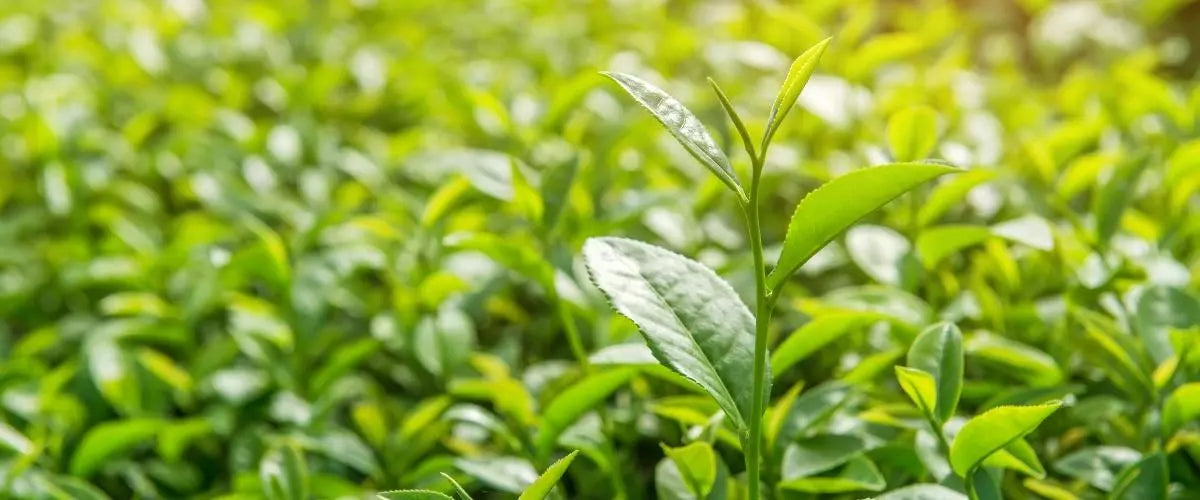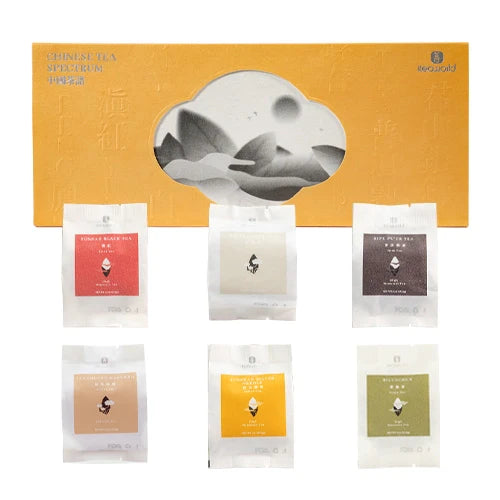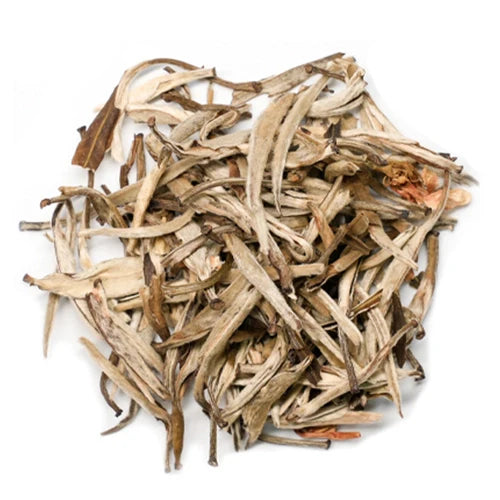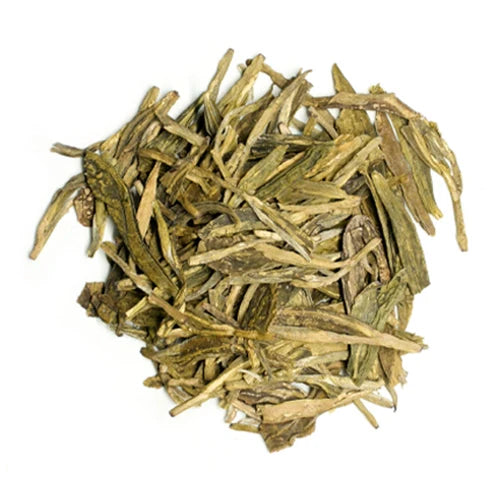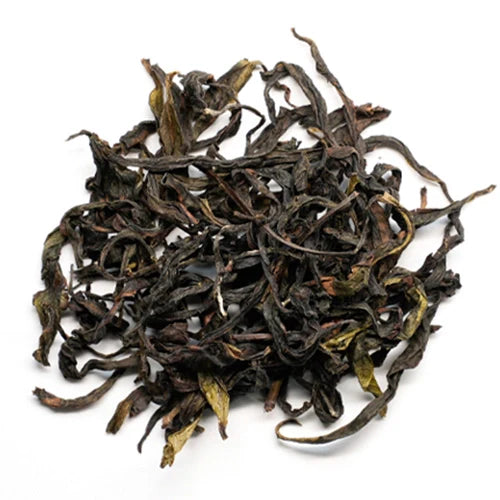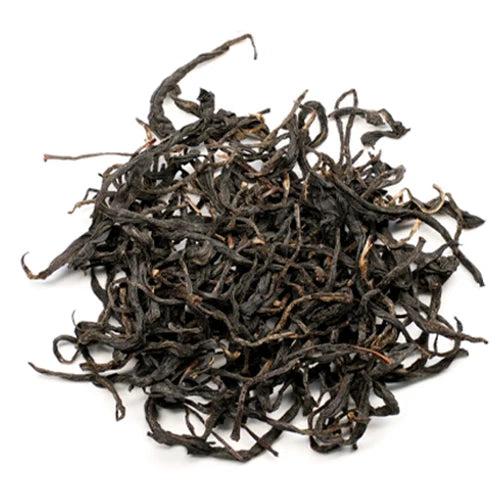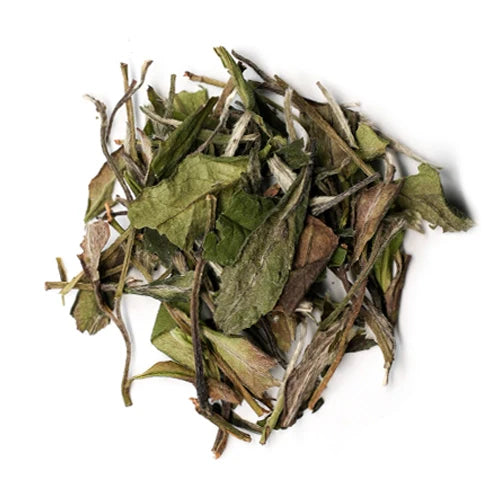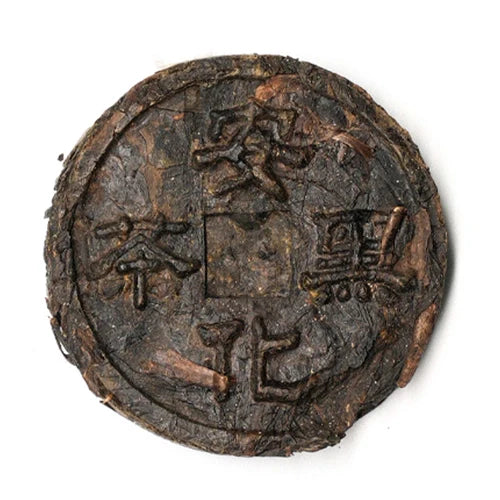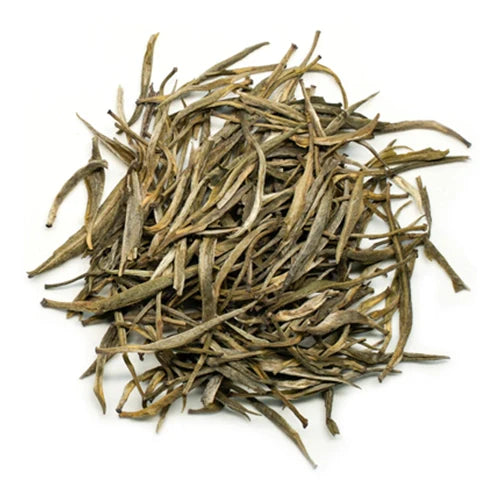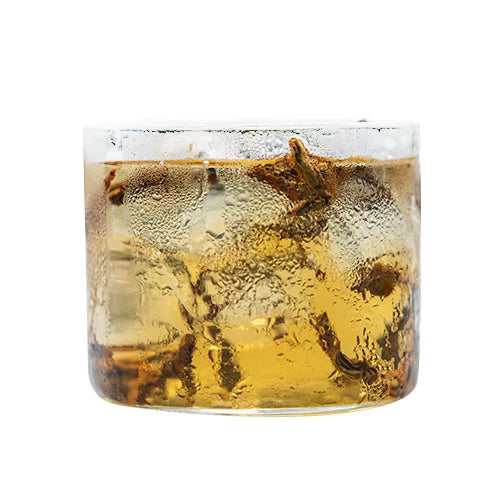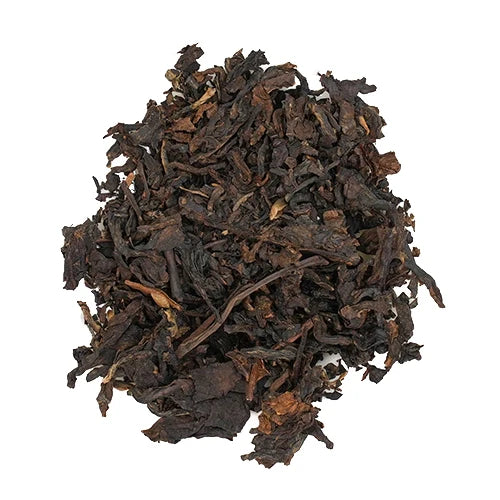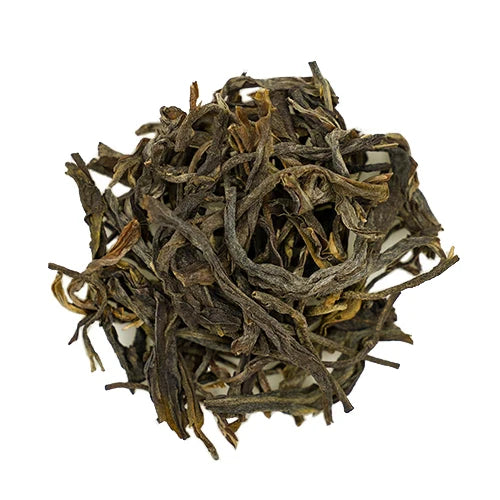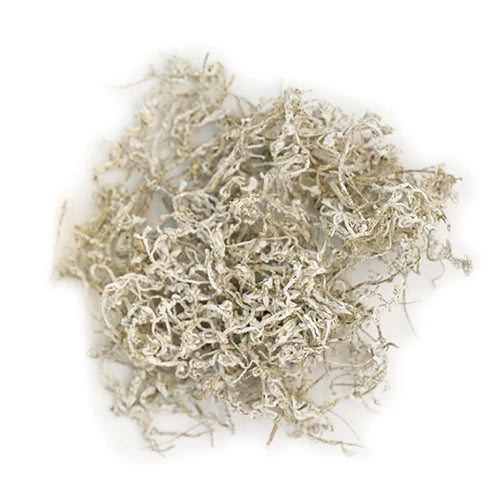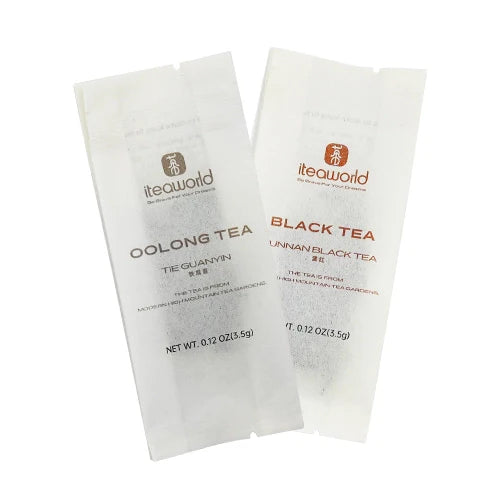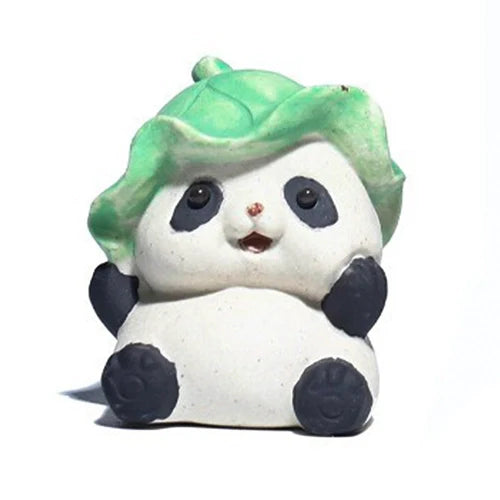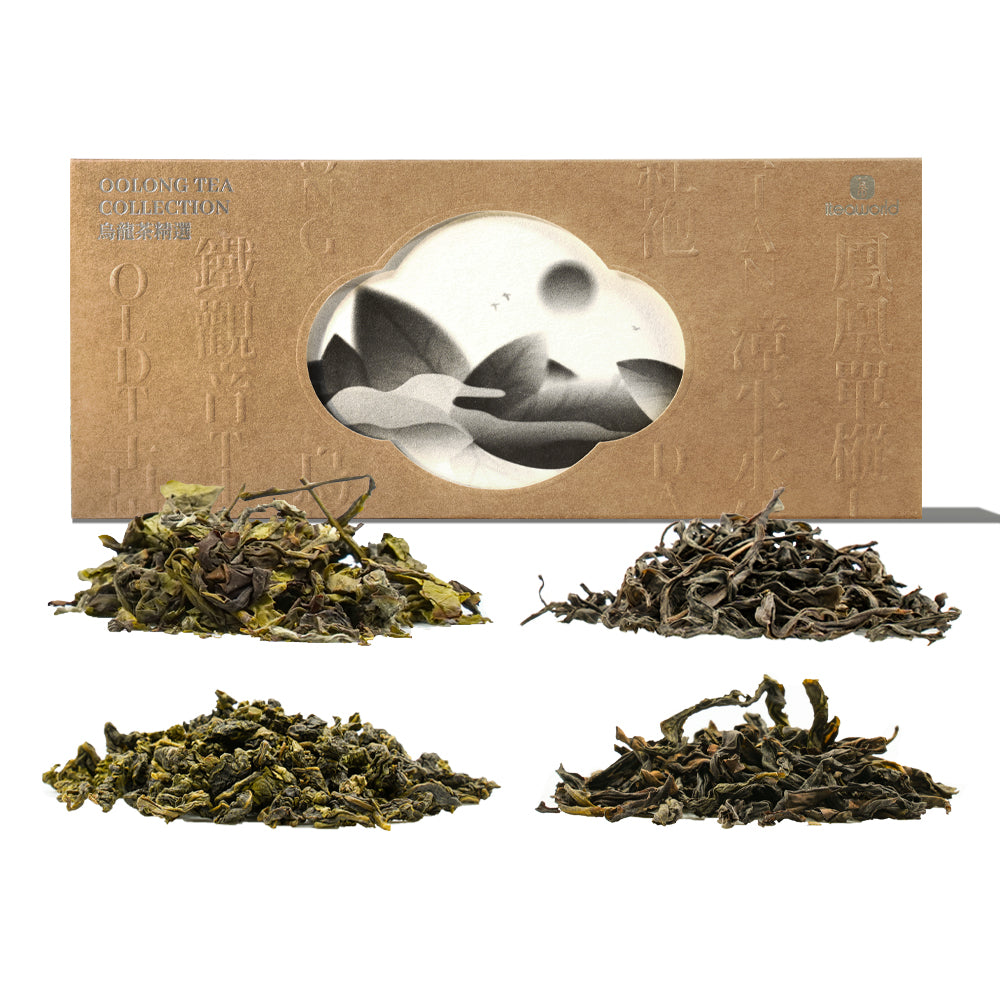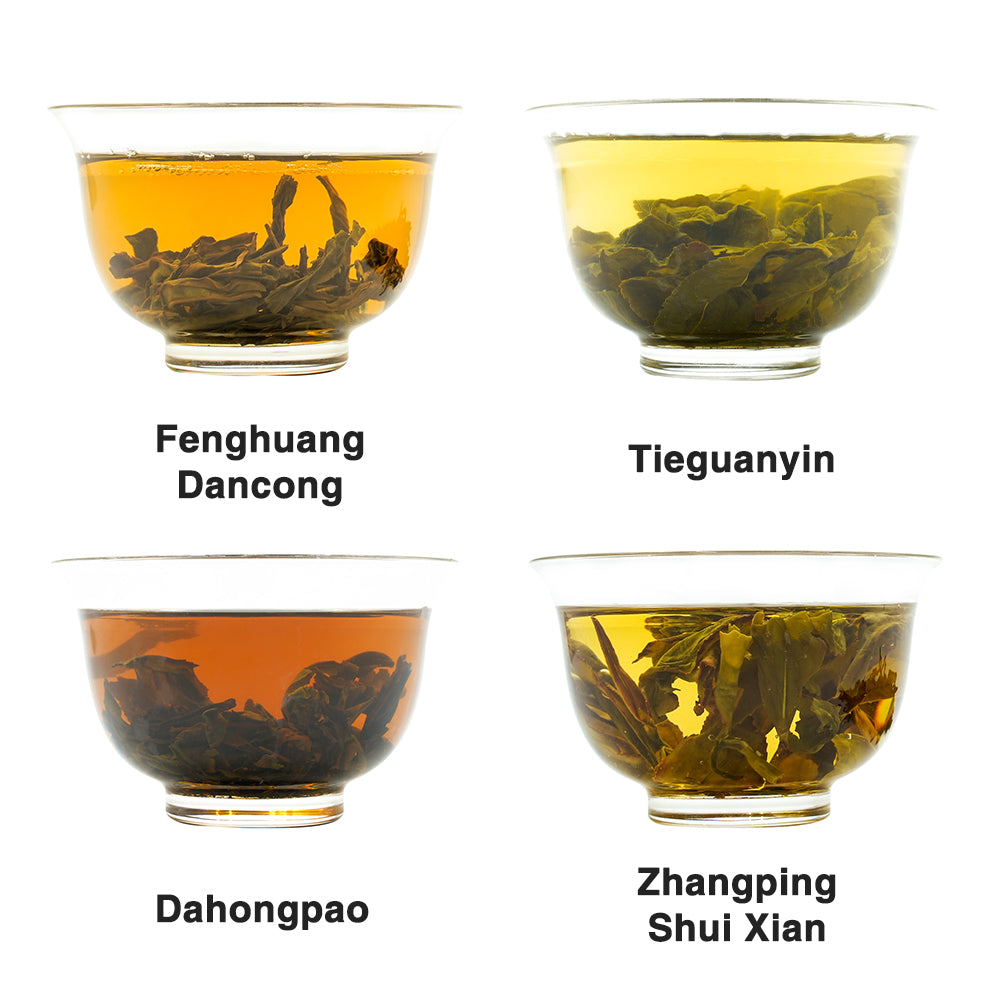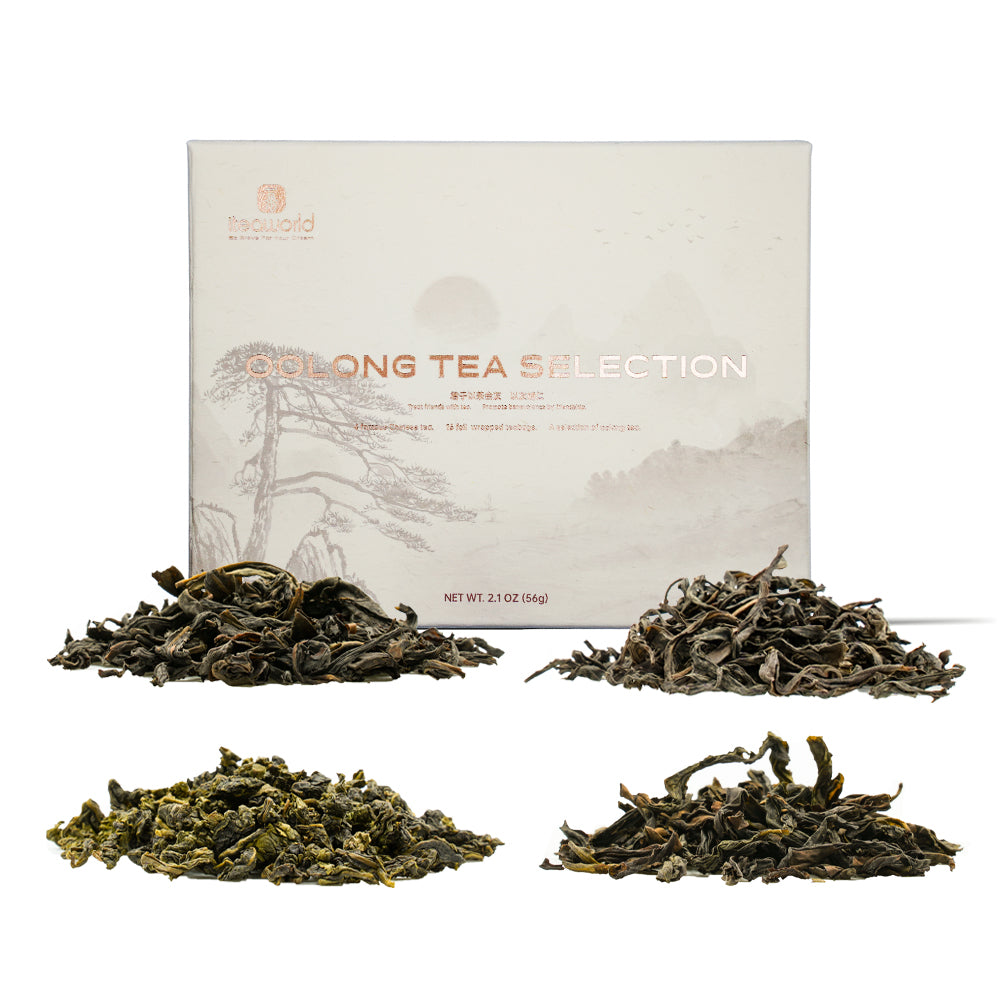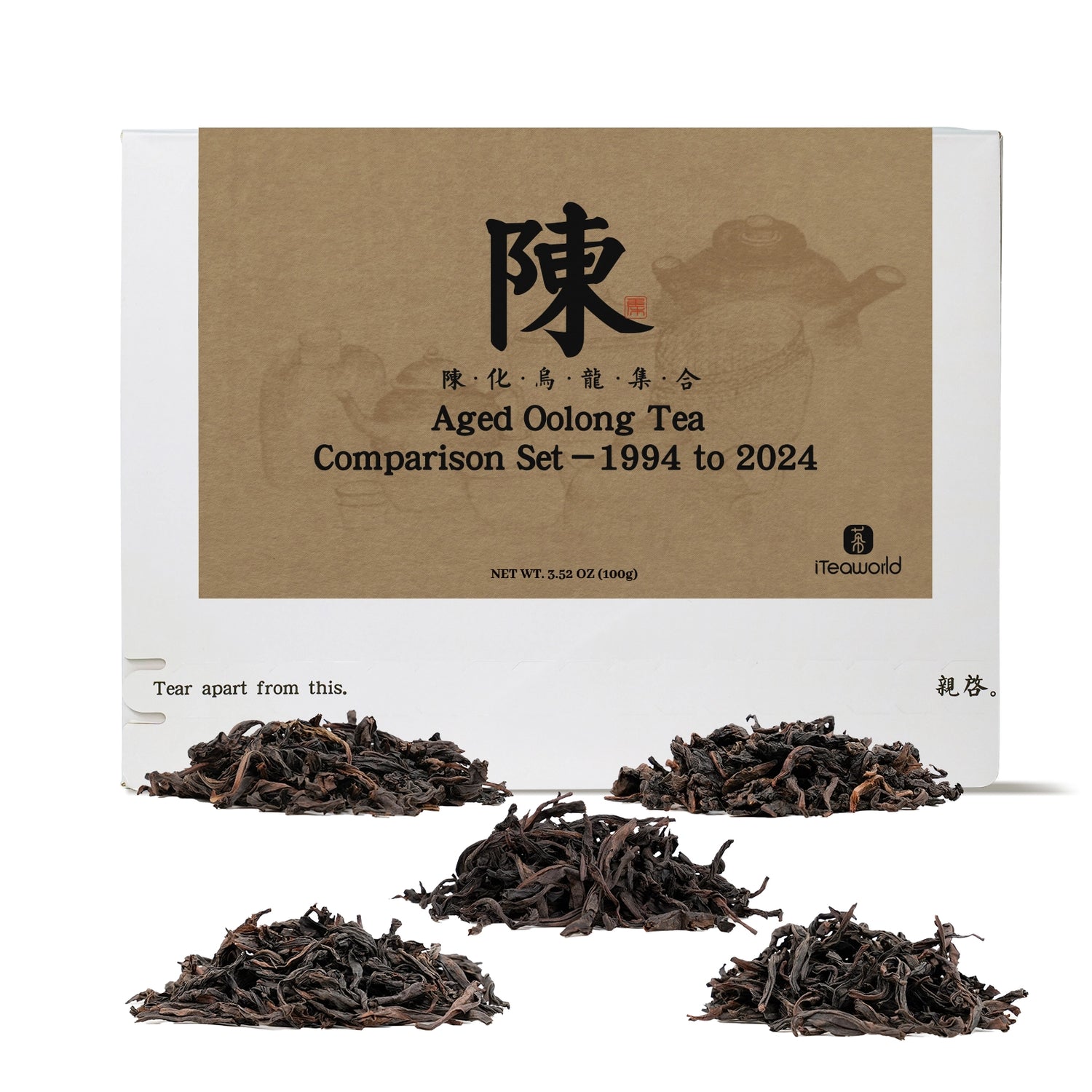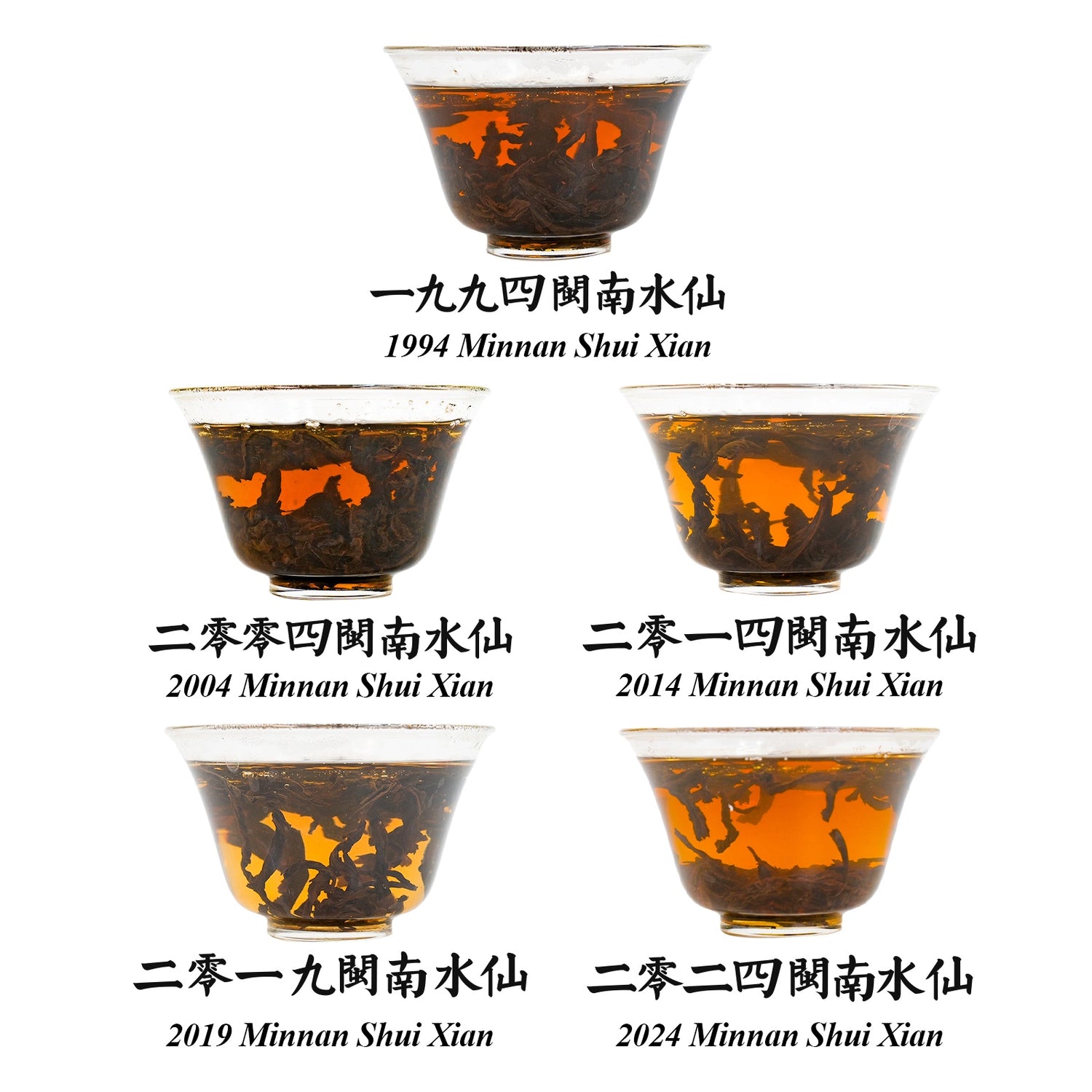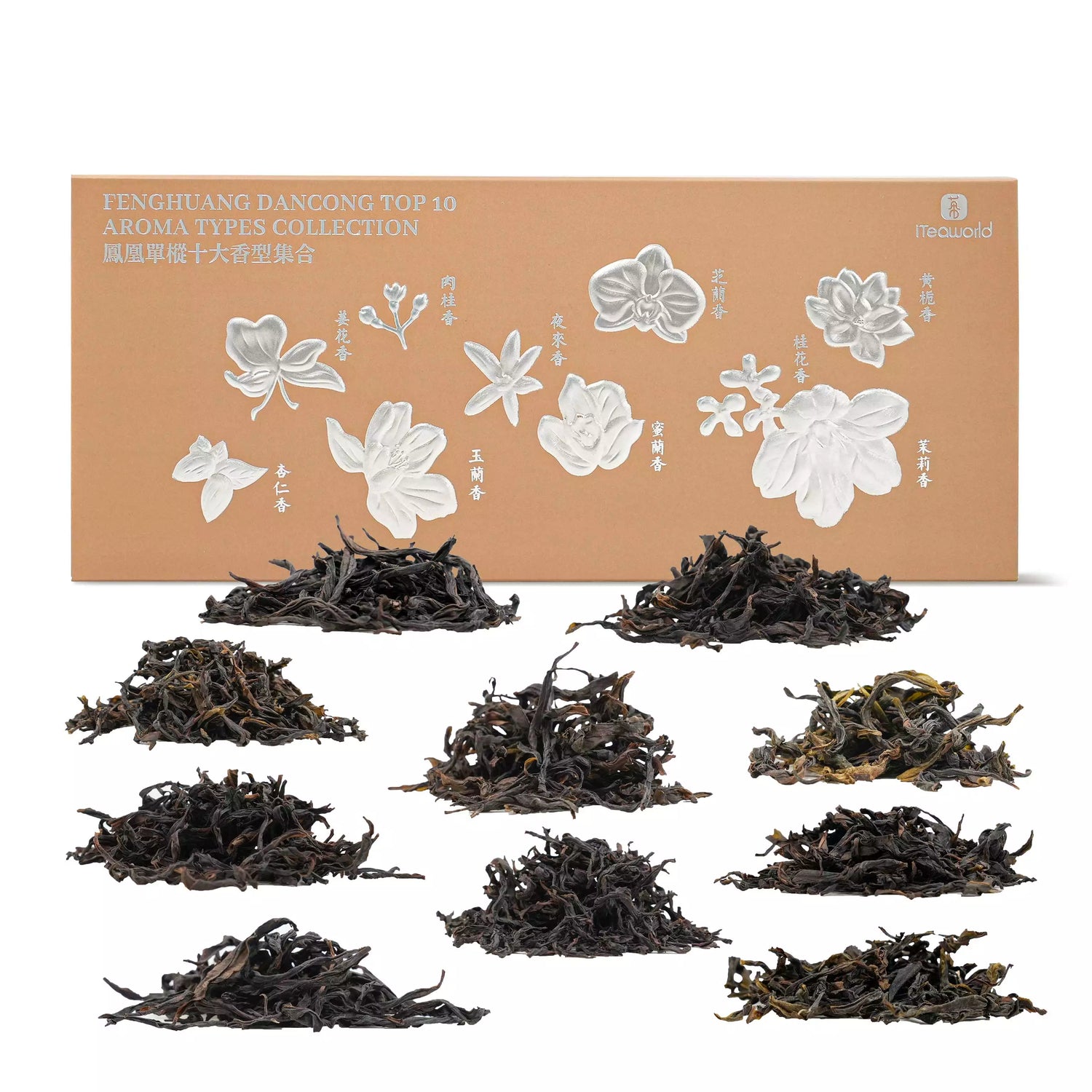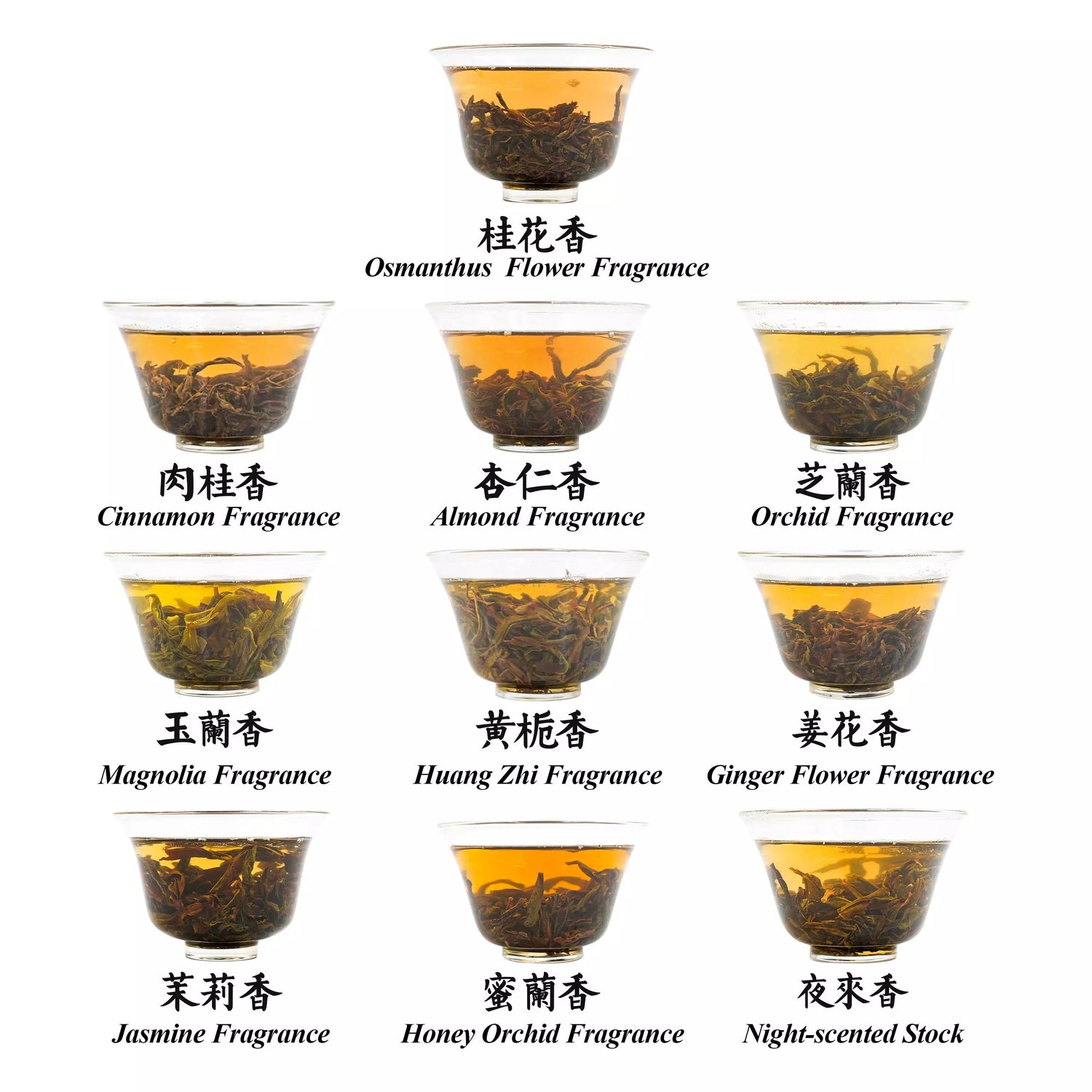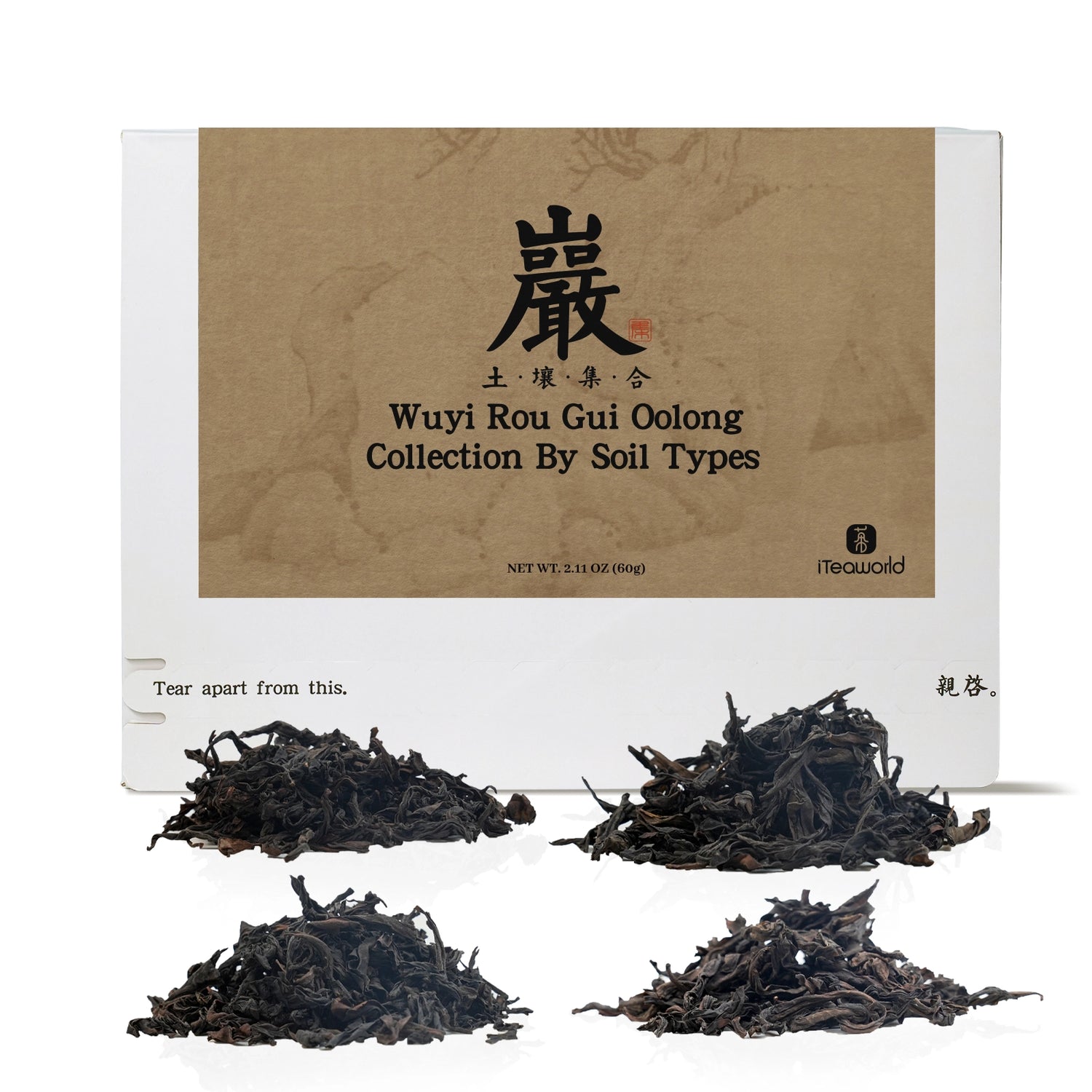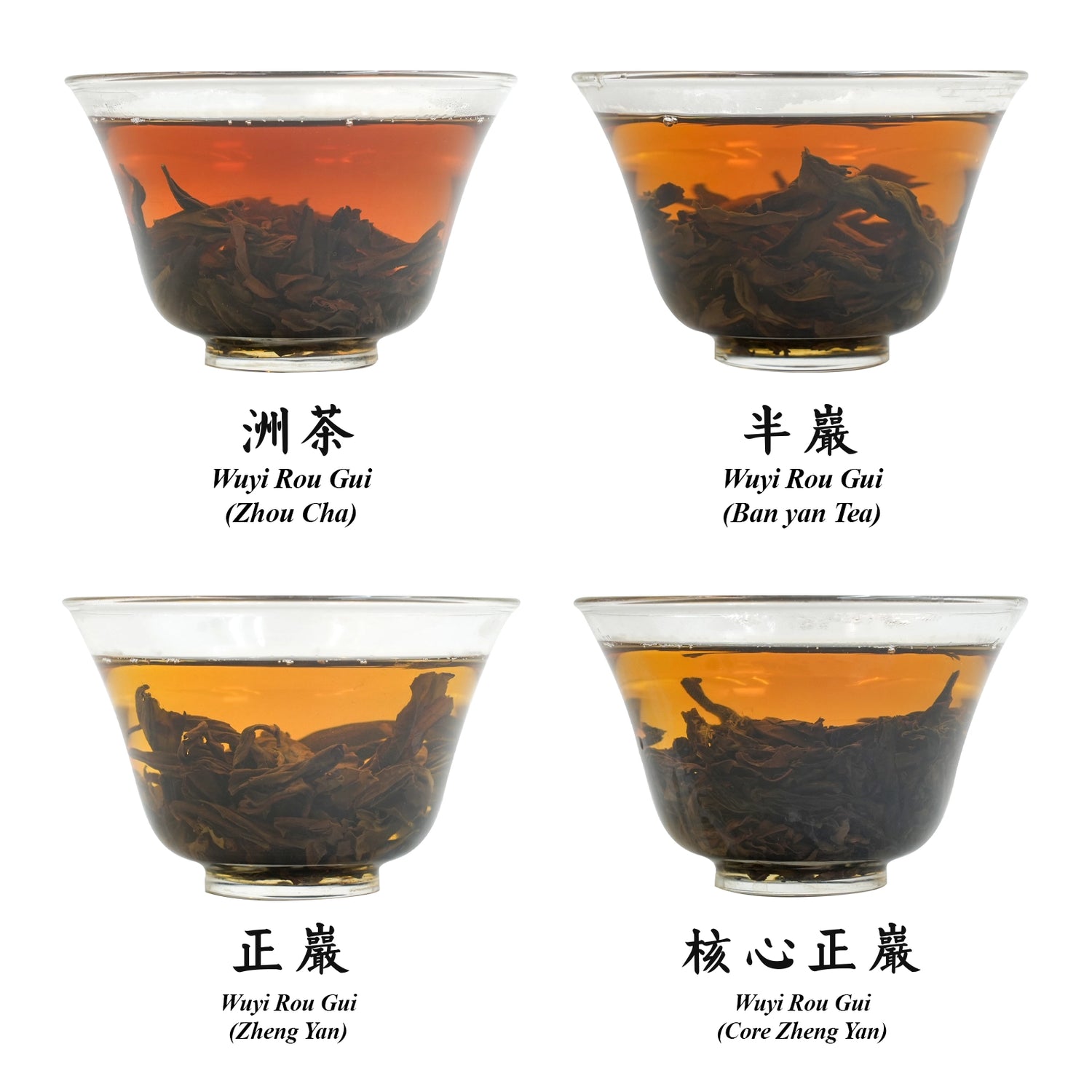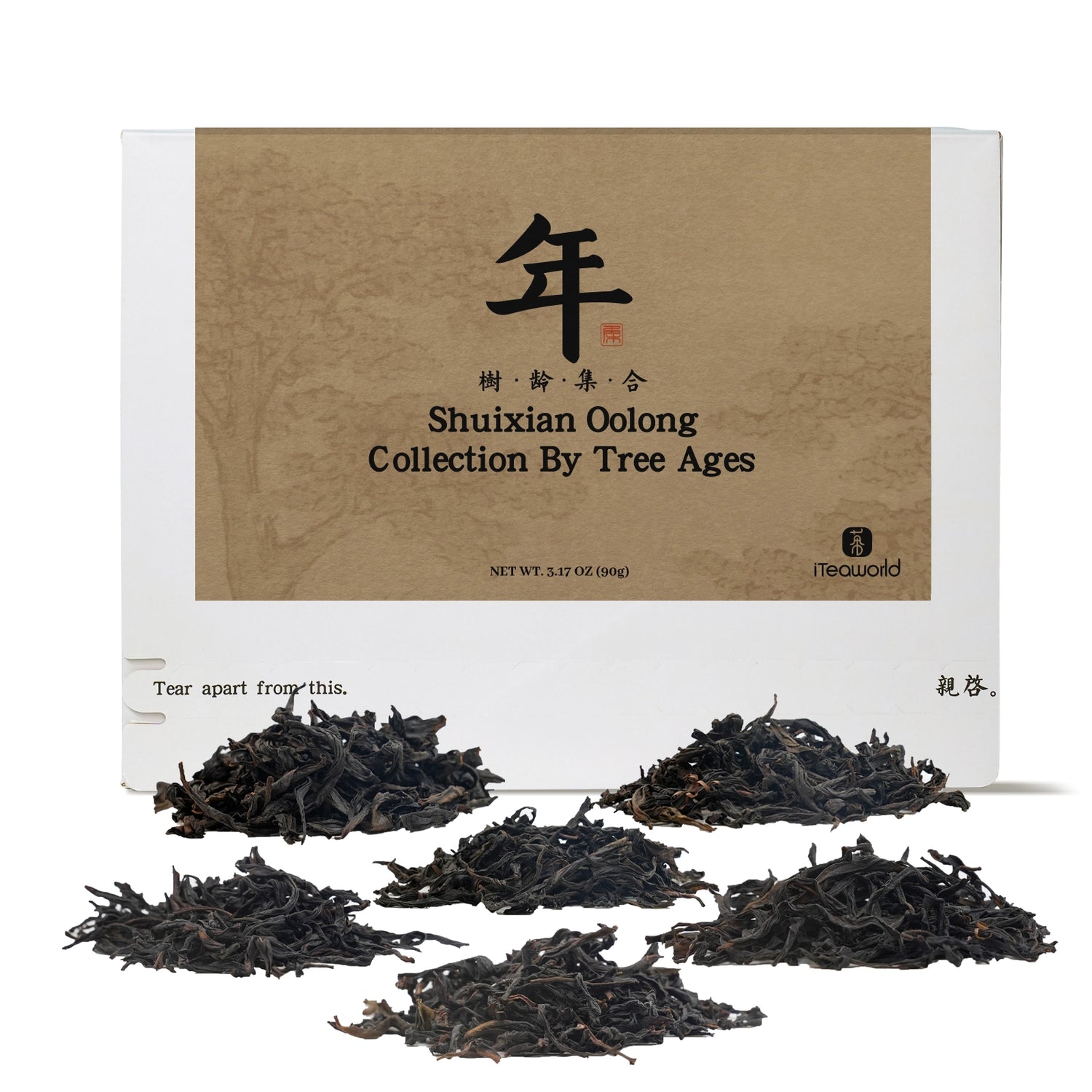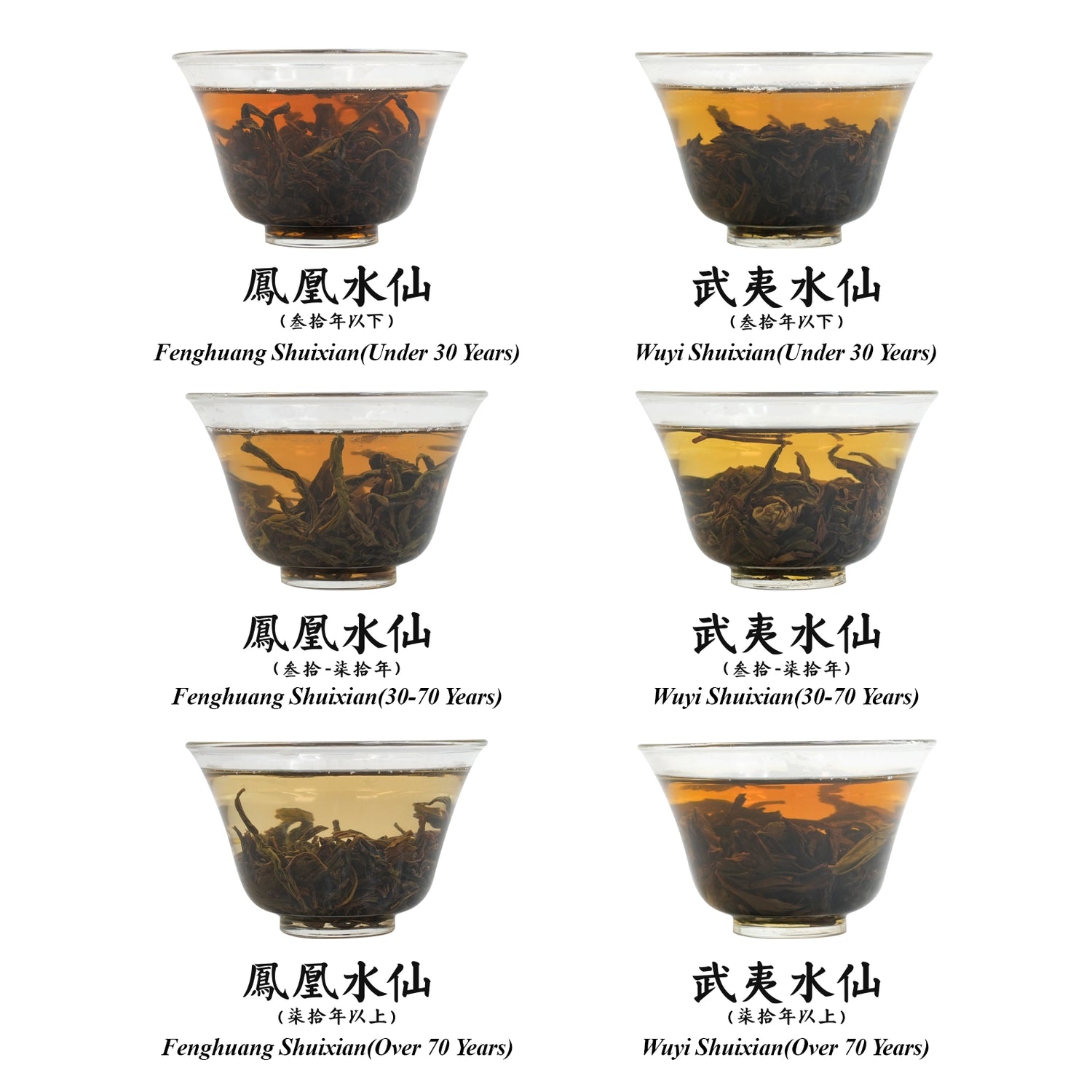Сортировать по:
15 продуктов
15 продуктов
Откройте для себя мир китайского чая улун с четырьмя культовыми сортами
Откройте для себя богатое разнообразие китайских улунов с этим тщательно подобранным набором, включающим Да Хун Пао, Те Гуань Инь, Феникс Дань Цун и Чжанпин Шуй Сянь. От слабоферментированных до сильно обжаренных горных чаев — этот набор станет идеальным знакомством для любителей чая, желающих открыть для себя всю гамму вкусов улунов.
- Да Хун Пао: насыщенный и поджаристый, из гор Уи
- Те Гуань Инь: легкий, цветочный и элегантный — классический миньнаньский улун
- Фэнхуан Дань Цун: Натуральный фруктовый вкус с насыщенным ароматом орхидеи
- Чжанпин Шуйсянь: Редкий прессованный улун с тонкими садовыми нотками
Независимо от того, являетесь ли вы новичком в улуне или ищете разнообразие, этот набор предлагает чувственное путешествие по лучшим чайным регионам Китая — все в одной элегантной коллекции.
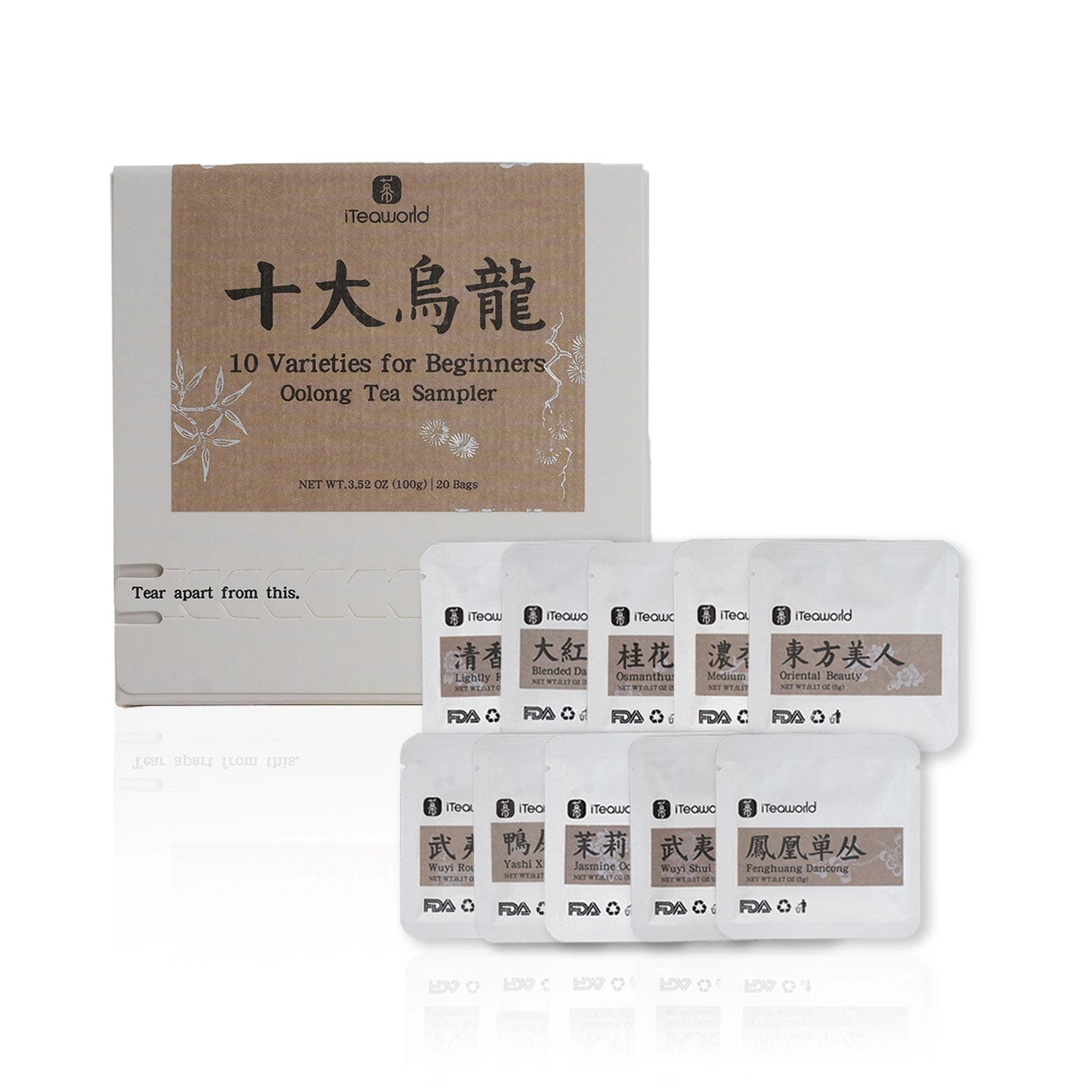

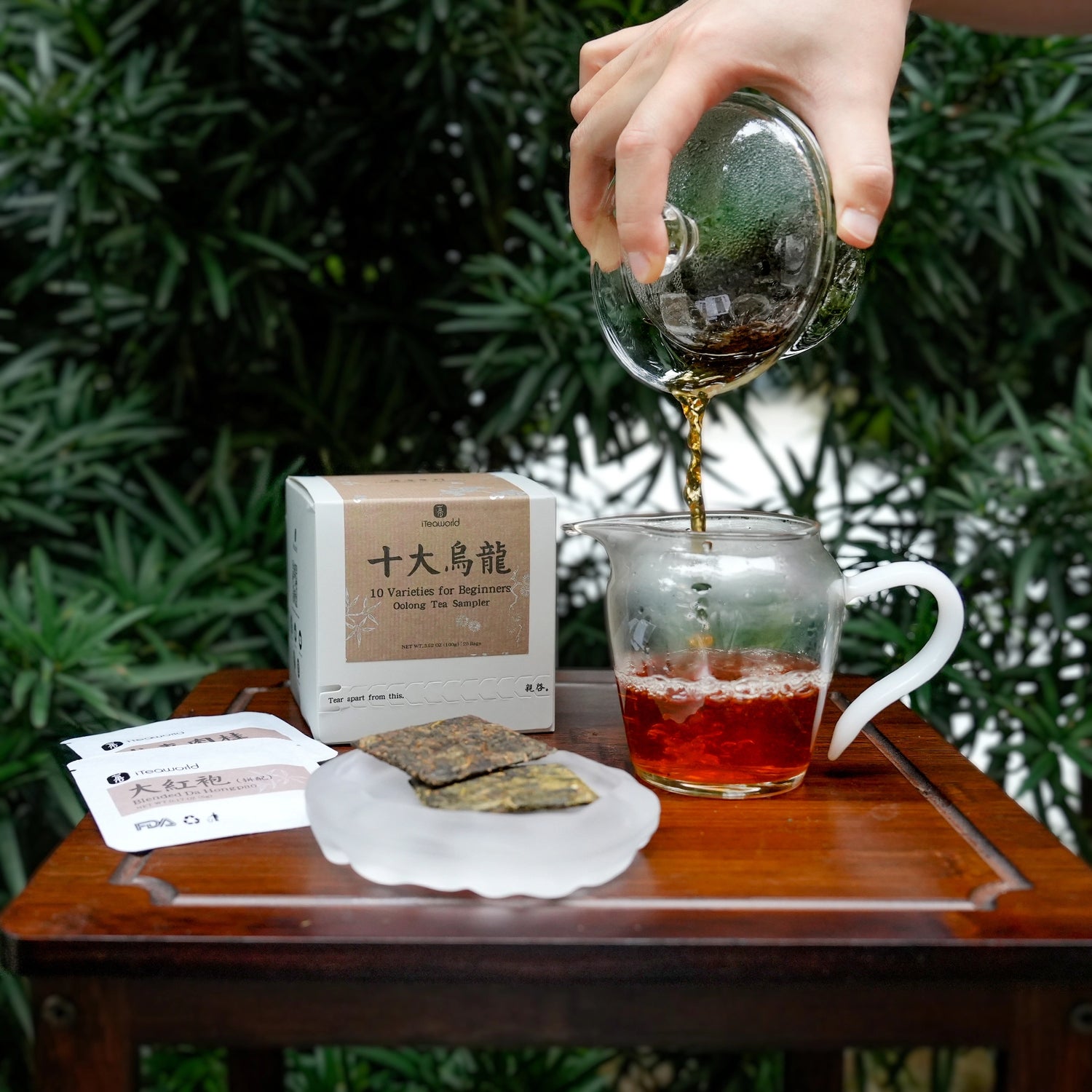
Коллекция улунских чаёв – 10 лучших классических чаёв для начинающих 100 г (20 пакетиков)
$19.99 USD
Цена за единицу товара заКоллекция улунских чаёв – 10 лучших классических чаёв для начинающих 100 г (20 пакетиков)
$19.99 USD
Цена за единицу товара заЛучшая коллекция улунского чая для начинающих, включающая 10 самых знаковых и популярных китайских улунских чаев, а также 2 мини-блинчика каждого сорта (всего 20 штук) .
Каждый чай изготавливается из тщательно отобранных листочков и прессуется в удобные мини-брикеты весом 5 г — просто бросьте их в горячую воду, никакие чайные принадлежности не требуются.
В этом тщательно подобранном наборе представлен широкий спектр натуральных вкусов улунов: от свежих цветочных нот Те Гуань Инь до насыщенного вкуса глубокой прожарки Да Хун Пао.
Абсолютно никакого добавленного сахара, искусственных ароматизаторов и красителей — только 100% натуральный чай.
Это идеальный способ познакомиться с настоящим китайским чаем улун и найти свои любимые сорта — путешествие в мир настоящего чая с минимальным риском и высокой ценностью без лишних хлопот.
Обратите внимание: поскольку мини-лепешки изготавливаются из целых листьев, которые размягчаются и прессуются, при заваривании могут появляться небольшие фрагменты листьев — это совершенно нормально и является частью натурального процесса заваривания чая.
В коллекцию улунских чаёв входят четыре известных рассыпных улуна из Китая: Те Гуань Инь, Миньнаньский Нарцисс, Да Хун Пао и Фэн Хуан Дань Цун. Она даёт возможность оценить разнообразие улунов: от освежающих, цветочных, медовых до фруктовых ароматов. Вы также сможете оценить разнообразие вкусов, обусловленное разницей в уровнях ферментации и интенсивности обжарки. Вы также откроете для себя уникальные ароматы, полученные как из современных высокогорных чайных садов, так и из древних чайных плантаций. Этот сборник упрощает процесс определения вашего любимого сорта улуна.
Вес нетто: 80 г, в упаковке 5 г. Больше чая по той же цене.
Каждая упаковка идеально подходит как для заваривания в стиле Гунфу, так и для заваривания в западном стиле — как раз нужное количество для одной заварки.
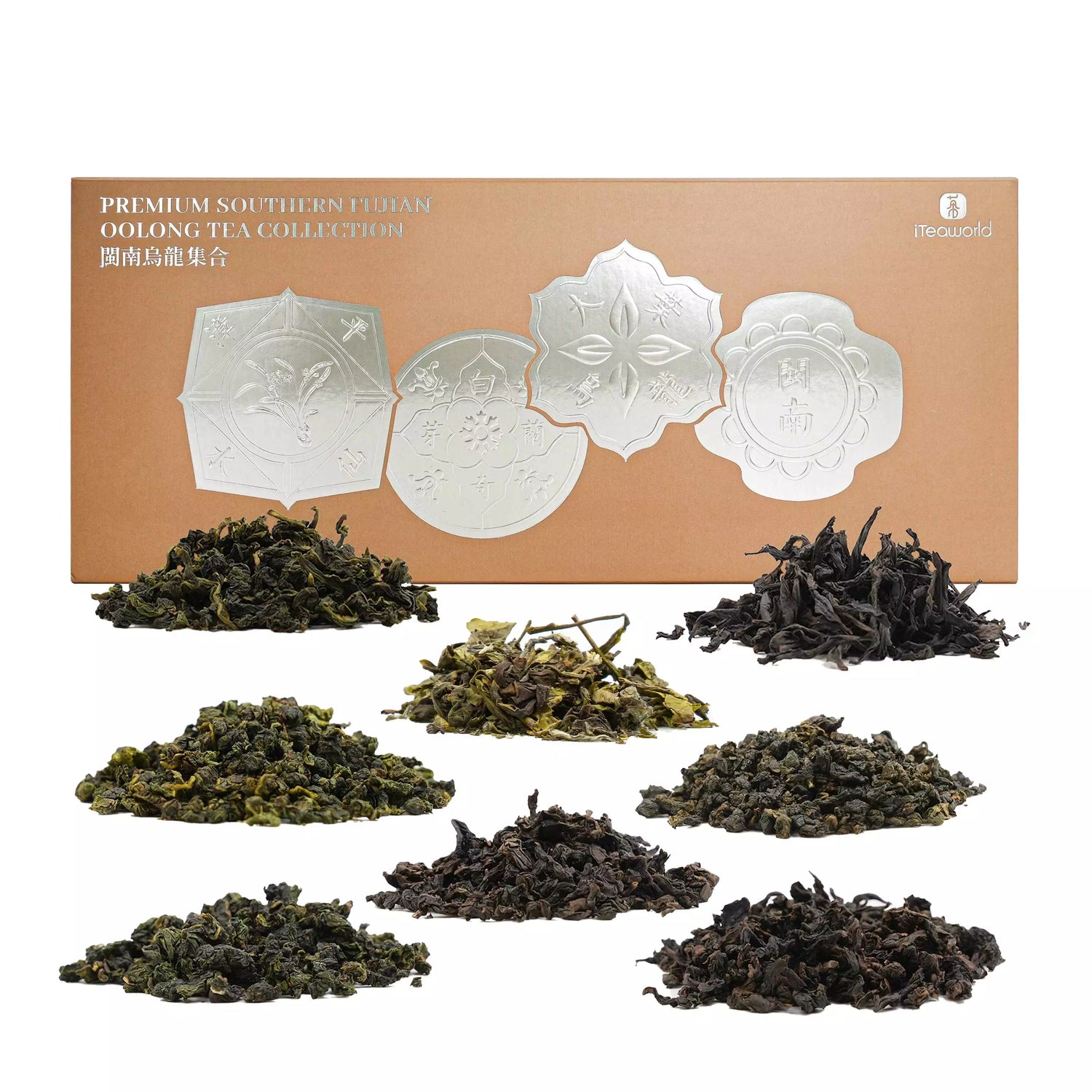
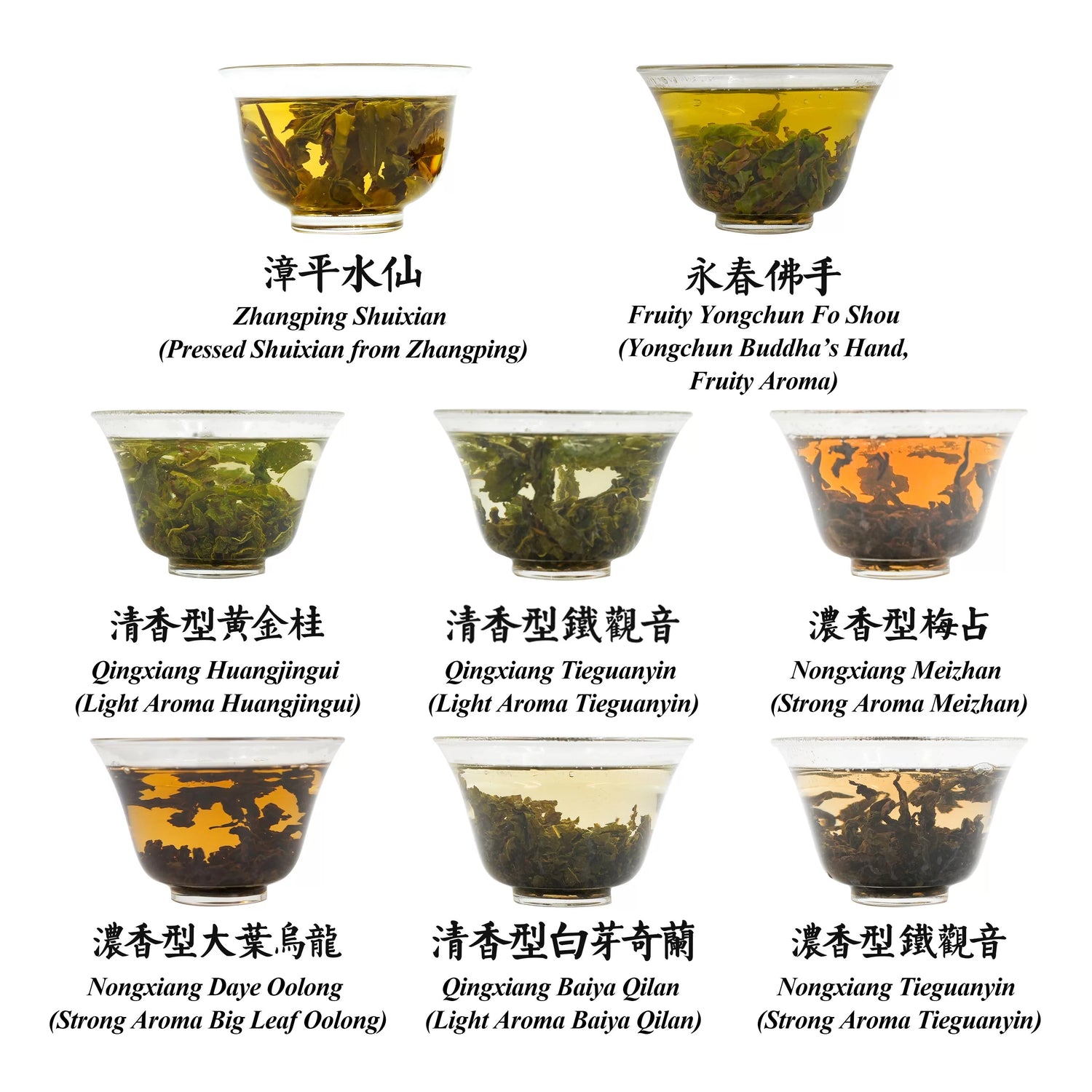
Коллекция улунов «Южная Фуцзянь» — 8 уникальных исторических вкусов 100 г
$29.99 USD
Цена за единицу товара заКоллекция улунов «Южная Фуцзянь» — 8 уникальных исторических вкусов 100 г
$29.99 USD
Цена за единицу товара заОткройте для себя богатое наследие южнофуцзяньских улунских чаёв — родины культовых Те Гуань Инь и Чжанпин Шуй Сянь, признанных частью нематериального культурного наследия Китая. С XVII века этот регион является пионером в производстве ароматных улунов, известных своими цветочными, фруктовыми нотами и лёгкой обжаркой. Эти чаи, изготовленные с использованием проверенных временем техник, таких как лёгкое окисление, многослойная обжарка и кропотливая формовка листьев, отражают суть миннаньской традиции. Независимо от того, являетесь ли вы опытным любителем чая или только начинаете свой путь, эта тщательно подобранная коллекция предлагает вам истинный вкус истории улунов.

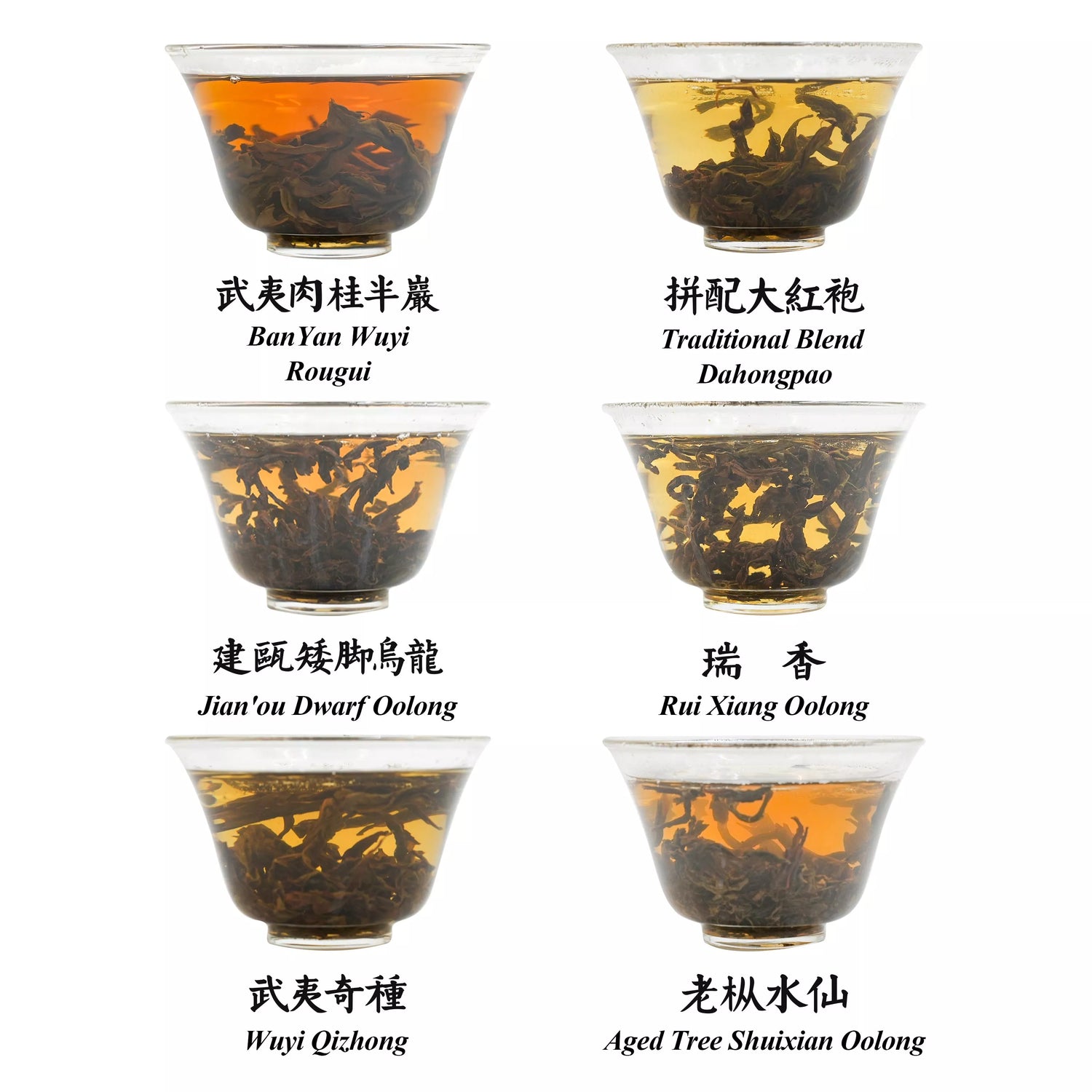
Коллекция улунов Северной Фуцзянь — 6 представительных вкусов 100 г
$39.99 USD
Цена за единицу товара заКоллекция улунов Северной Фуцзянь — 6 представительных вкусов 100 г
$39.99 USD
Цена за единицу товара заСеверный Фуцзянь считается родиной улуна, а традиционные методы производства чая Wuyi Rock Tea признаны частью нематериального культурного наследия Китая. Эта коллекция включает в себя культовые сорта улунов от династии Сун (Уи Цичжун и улун Цзяньоу Карликовый) до наших дней (Блендированный Да Хун Пао, Уи Жугуй, Улун Шуйсянь Выдержанного Дерева), а также новые сорта с большим потенциалом (Улун Жуйсянь). Каждый чай несет в себе уникальное мастерство региона, свою неповторимую историю и вкус. Мы надеемся, что эта коллекция позволит вам открыть для себя разнообразие вкусов и богатое культурное наследие улуна из Северной Фуцзянь (Миньнань).
Состав продукта:
Уи Цичжун*3 пакетика* 5г
Карликовый улун Цзяньоу*3 пакетика* 5 г
Смесь Да Хун Пао*4 пакетика* 5 г
Уи Руги *4 пакетика* 5г
Выдержанный чай Шуйсянь улун*3 пакетика* 5 г
Улун Руй Сян*3 пакетика* 5 г
Время обработки: ноябрь 2024 г.
Срок годности: 36 месяцев
Чай улун из Миннаня: чашка, история, предание
1. Происхождение (династии Тан и Сун)
- Для производства чая «бэйюань» (разновидности пропаренного зелёного чая) местные жители использовали чай «Уи цайча» (Qi zhong) . Во время транспортировки листья соприкасались, в результате чего некоторые из них краснели и подвергались частичному окислению, приобретая полуферментированные свойства, которые считаются истоками чая «улун».
2. Рождение (династия Мин)
- После того как император Чжу Юаньчжан запретил прессованные чайные лепешки, фермеры-чаеводы горы Уи объединили методы обработки зеленого и черного чая, чтобы создать полуферментированный улун.
3. Развитие (династия Цин)
- Чай Уи-Цай (Ци Чжун): к эпохе династии Цин, чай Уи-Цай (Wuyi Rock Tea) разработал основные методы сушки на солнце, встряхивания и обжаривания. Система чая Уи-Цай достигла зрелости, и первыми представителями этого чая стали чай Уи-Цай (Ци Чжун) и четыре его известных сорта (Да Хун Пао, Бай Цзи Гуань, Те Ло Хань, Шуй Цзинь Гуй).
- Карликовый улун Цзяньоу: Карликовый улун (также известный как улун Сяо Е) родом из города Дунфэн Цзяньоу был завезен на гору Уи, где его усовершенствовали с помощью мастерства, включая обжарку на древесном угле, что придало ему характерный персиковый аромат и выраженный минеральный привкус, что сделало его фаворитом для купажирования и дало ему прозвище «Премьер-министр чая».
- Уи-жуй: Жоу-гуй, ещё один знаменитый горный чай, берёт своё начало в эпоху династии Цин. Когда-то он был редким и встречался лишь в скалистых районах Уи, но в 1960-х годах его ареал значительно расширился благодаря вырубке и размножению.
- Уи Шуйсянь: Чай Шуйсянь, завезенный из Цзяньяна в 1800-х годах, стал классикой провинции Фуцзянь благодаря своему насыщенному древесному вкусу и плотной текстуре.
4. Процветание (с XX века по настоящее время)
- Смешанный Да Хун Пао: В XX веке прорыв в методах бесполого размножения позволил успешно размножить Да Хун Пао путем черенкования в 1982 году, что привело к массовому производству чистого Да Хун Пао после того, как в 2006 году прекратился сбор урожая с материнского дерева.
- Жуйсян: Новые гибридные сорта, такие как Цзинь Мудань, Хуан Гуаньинь и Жуйсян, были выведены путём скрещивания традиционных сортов, таких как Жоу Гуй, Шуй Сянь и Хуан Цзинь Гуй. Жуйсян, в частности, известен своим постоянно меняющимся ароматом — от ладана и гардении до османтуса, персика и мёда, — за что получил прозвище «Изменитель облика» среди горных чаёв.
Уникальные характеристики крафта:
1. Интенсивная ферментация и окисление
Северофуцзяньские улуны обрабатываются по уникальной технологии: более длительное завяливание на солнце, лёгкое, но многократное встряхивание, несколько циклов окисления и глубокая ферментация. По сравнению с южнофуцзяньскими улунами (которые окислены на 10–30%), северофуцзяньские улуны имеют степень окисления от 25 до 55%, что придаёт чаю насыщенный янтарно-золотистый цвет и более мягкий, насыщенный вкус.
2. Процесс обжарки древесного угля
Обжарка на древесном угле — фирменная техника производства улунских чаёв Северной Фуцзянь. Она включает три ключевых этапа:
Первичная обжарка («Water Walk»): высокая температура (~150 °C) используется для быстрого удаления поверхностной влаги и травянистых ноток.
Вторая обжарка (медленная обжарка): щадящая, продолжительная обжарка, длящаяся 10–18 часов, с постепенным понижением температуры до ~80 °C. На этом этапе раскрываются насыщенные карамельные и минеральные ноты.
Финальная обжарка (выдержка): очень медленная обжарка при температуре 60–80 °C в течение 12–24 часов. Этот этап снижает влажность листа до 3–5%, увеличивая срок хранения и потенциал выдержки.
Для обеспечения равномерной обжарки используется только плотный уголь из твердых пород древесины, например, лонгана или личи.
Этот традиционный метод придает чаю теплый, округлый вкус с глубоким ароматом обжарки, более мягкий и изысканный характер, чем резкий вкус чая, обжаренного с помощью электрочайника.
3. Раскатка и формовка
Никакого скручивания — в отличие от южнофуцзяньских улунов, северофуцзяньские улуны не скручиваются плотно, сохраняя свою длинную, скрученную форму листа с глянцевым темным оттенком и красновато-коричневыми бликами.
Двойная обжарка и скручивание — чай обжаривается и скручивается дважды, что обеспечивает равномерное высвобождение его внутренней эссенции и создание более густого, шелковистого чайного настоя.
Рекомендации по завариванию:
Чайная посуда:
Гайвань (110–150 мл): лучше всего подходит для ароматных чаев (Руги, Данги).
Чайник из исинской глины: идеально подходит для сильно обжаренных или выдержанных чаев.
Вода:
Используйте родниковую или очищенную воду температурой 100°C (кипящую).
Соотношение чая и воды:
5 г чая / 110 мл воды.
Советы по завариванию:
Разогрейте и пробудите чай.
Высокий уровень налива для аромата, низкий уровень налива для мягкости.
Первые 3 проливайте быстро (5–10 с), затем увеличьте время настаивания.
Полностью сливайте воду после каждой варки.


Коллекция чая Гуандун Улун: 6 исторических вкусов для любителей чая, 100 г
$49.99 USD
Цена за единицу товара заКоллекция чая Гуандун Улун: 6 исторических вкусов для любителей чая, 100 г
$49.99 USD
Цена за единицу товара за Путешествие в суть гуандунского улуна в коробке
От древнего улуна Шигупин, созданного народностью Шэ более 1500 лет назад, до современных ароматных чаёв Даньцун, этот тщательно отобранный набор включает шесть фирменных чаёв из Чаочжоу, Мэйчжоу и Жаопина — трёх основных регионов провинции Гуандун. Насладитесь ароматным путешествием по 500-летнему наследию чайного искусства.
Чтобы исследовать, как выдержка меняет вкус чая, мы выбрали пять чаев Миньнань Шуйсянь, обжаренных по традиционной технологии на углях, от зарубежной китайской чайной фабрики Yongchun Beikeng — урожая 1994, 2004, 2014, 2020 и 2024 годов.
Это дегустационное путешествие покажет, как время преображает богатый характер улуна Шуйсянь. Давайте вместе прочувствуем эту эволюцию.
В этот набор входит:
Чай Миньнань Шуйсянь 2024 года (обжаренный на углях, с насыщенным ароматом)* 20 г
Миньнань Шуйсянь 2019 года (обжаренный на углях, с насыщенным ароматом)* 20 г
Миньнань Шуйсянь 2014 года (обжаренный на углях, с насыщенным ароматом)* 20 г
Миньнань Шуйсянь 2004 года (обжаренный на углях, с насыщенным ароматом)* 20 г
1994 Minnan Shui Xian (обжаренный на углях, с насыщенным ароматом)* 20 г
Эволюция вкуса (для справки)
2024 (Новый Чай):
В чае доминирует натуральный аромат орхидеи с нотками обжаренных на углях нот. Аромат яркий и стойкий — при заваривании кипящей водой поднимающийся пар приобретает насыщенную цветочную ноту. Чай оставляет в чашке чистый, стойкий аромат. Вкус насыщенный, мягкий и сладкий, с богатым, но без горечи, послевкусием. Он обеспечивает выраженную, возвращающуюся сладость и долгое, стойкое послевкусие. Настой крепкий, но не слишком бодрящий.
5-летний (2020):
Аромат орхидеи угасает, угольные ноты отступают. Начинают проявляться нотки спелых фруктов и лёгкий оттенок свежей древесины. Появляется лёгкая кислинка, но чай всё ещё стимулирует слюноотделение. Общий вкус становится более мягким, хотя и немного тоньше по сложности.
10-летний (2015):
Кислотность уменьшается. Выдержанные ноты (например, сухое дерево) смешиваются с лёгкими оттенками орхидеи. Свежесть исчезает. Ликер становится шелковистым, а возвращающаяся сладость сменяется мягкостью, напоминающей каменно-сахарный вкус.
20-летний (2005):
В аромате доминируют выдержанные ноты (сандал, травы). Напиток приобретает янтарный цвет, становится густым и насыщенным, как рисовый суп. Послевкусие глубокое, с лекарственными оттенками.
30 лет (1995):
Сложное сочетание выдержанных и травяных нот (например, женьшеня и сушеной цитрусовой цедры). Напиток густой, мягкий и почти маслянистый. Сладость тонкая и изысканная, с длительным послевкусием, напоминающим выдержанный напиток.
Как заваривать?
Чайная посуда:
Для заваривания свежего чая используйте гайвань или исинский чайник.
Для чая, выдержанного 5–10 лет, используйте исинский чайник.
Для заваривания чая, выдержанного 20 лет и более, используйте старый исинский чайник или грубый глиняный горшок.
Температура воды:
Свежий чай: 95–100°C
Выдержанный чай: 100°C
Соотношение чая и воды:
1 г чая на 20 мл воды
Пробуждение чая:
Для чая, выдержанного 5–10 лет: откройте пакетик и дайте чаю подышать около 5 минут перед завариванием.
Для чая, выдержанного 20+ лет: откройте пакет и дайте ему проветриться за день.
Крутое время
Сначала промыть:
Первый заваривание: быстрое 3-секундное ополаскивание, сливаем — это нужно для того, чтобы чай прогрелся и пробудился.
2–4-е заваривание: 8–15 секунд
Начиная с 5-го заваривания: увеличивайте время на 5–10 секунд на каждую заварку.
Для выдержанного чая (20+ лет):
Можно заваривать непосредственно перед употреблением или заваривать в чайнике 10 раз перед кипячением.
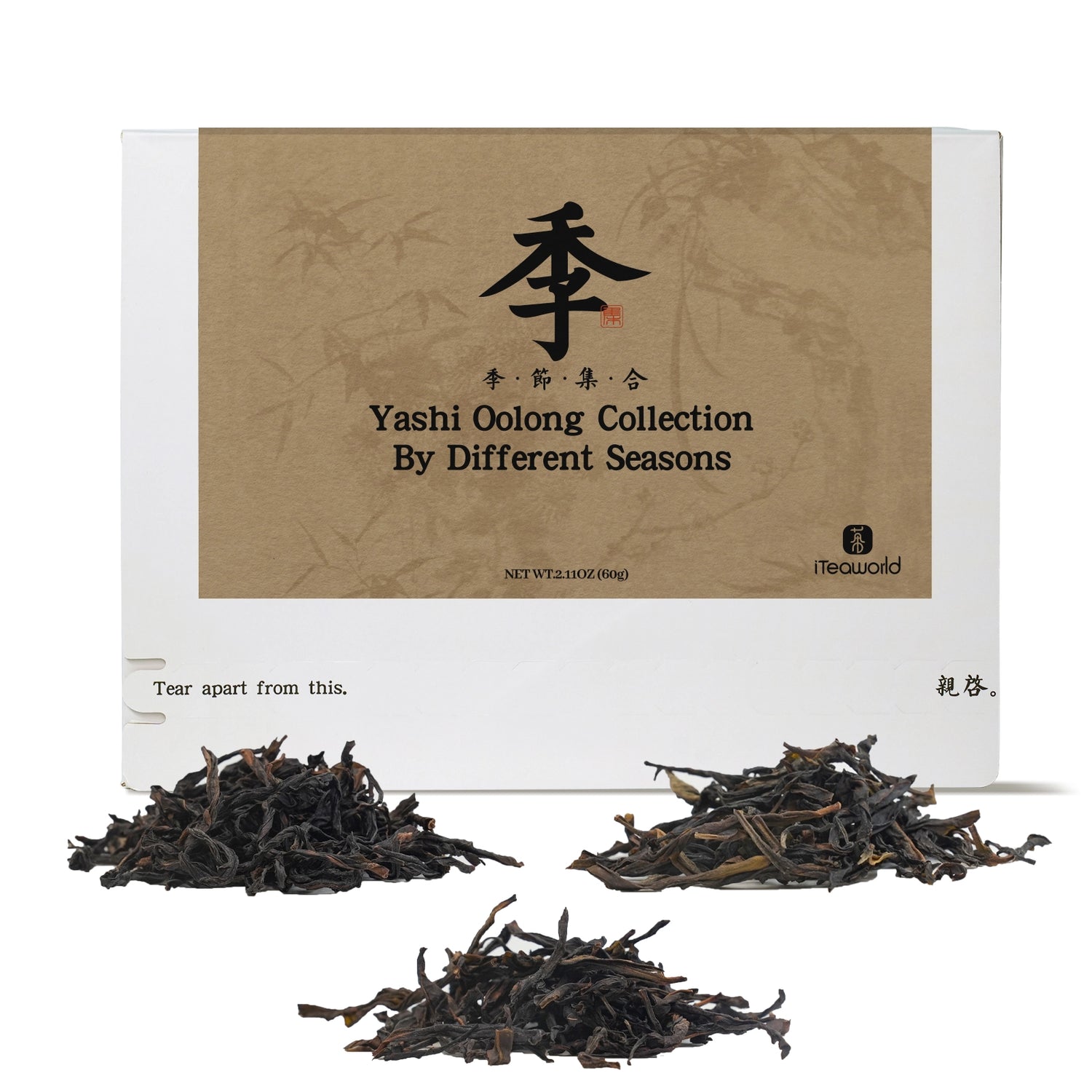
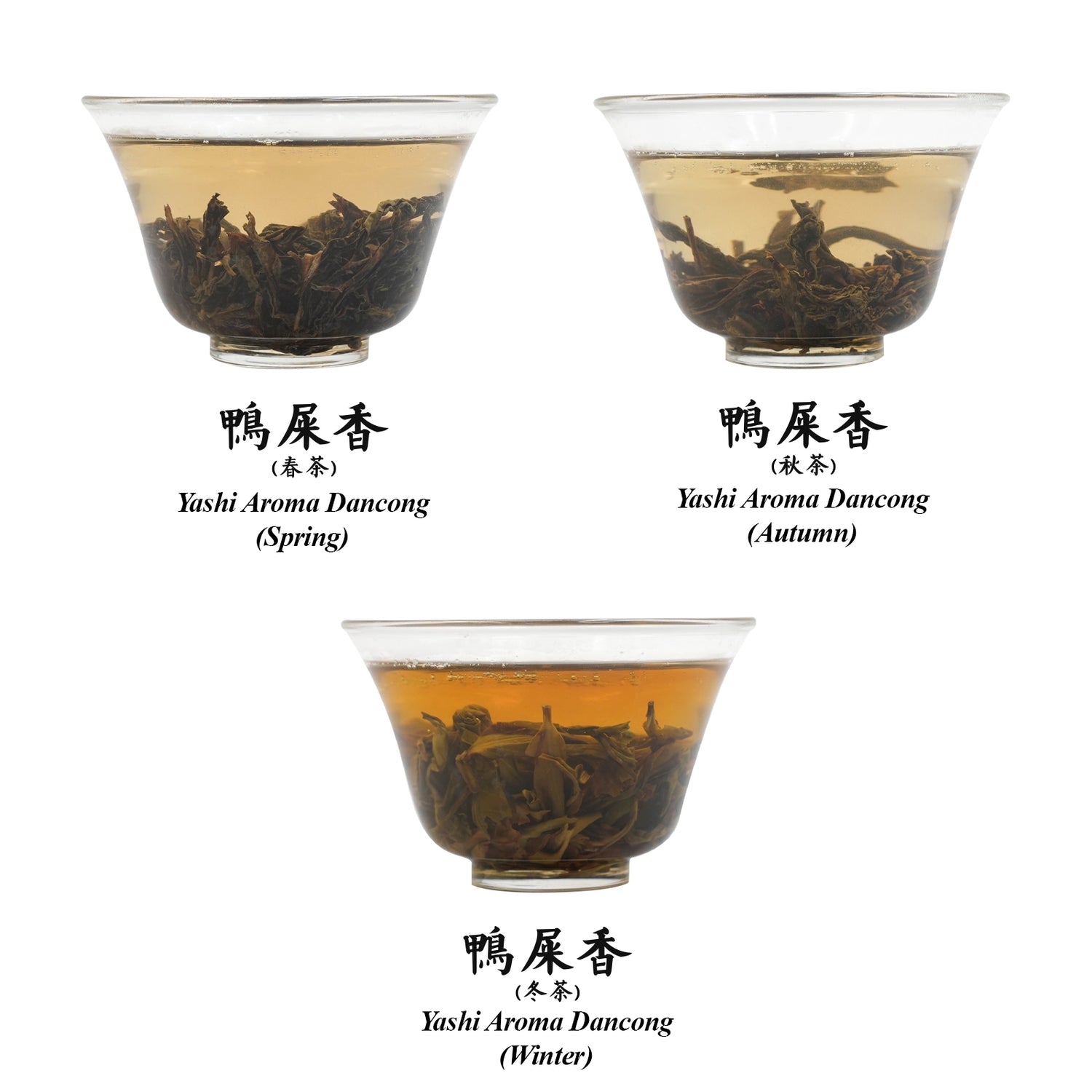
Сравнительный набор улунов Я Ши Сян – весенние, осенние и зимние сорта 60 г
$19.99 USD
Цена за единицу товара заСравнительный набор улунов Я Ши Сян – весенние, осенние и зимние сорта 60 г
$19.99 USD
Цена за единицу товара заСезонность чая улун
Улун можно собирать в любое время года: весной, летом, осенью и зимой. Однако уишанский чай собирают только весной. Улун, собранный в полдень, обычно обладает наиболее выраженным ароматом. Летние чаи чаще всего используются для приготовления молочного чая и реже встречаются на рынке листового чая.
Весенние чаи, как правило, растут медленнее, что приводит к повышению уровня аминокислот и полифенолов чая при более низком соотношении фенолов к аминокислотам. Однако из-за частой дождливой погоды в таких регионах, как Фуцзянь и Гуандун, весенние чаи могут содержать меньше ароматических соединений, чем осенние или зимние. Поэтому осенние и зимние улуны, как правило, обладают более выраженным ароматом. Зимние улуны, в частности, могут иметь даже свежий, прохладный аромат. Весенние улуны, напротив, обычно богаче веществами, что обеспечивает более сладкий и свежий вкус.
Этот продукт включает три разных сезонных чая с ароматом утиного помёта от одного и того же чайного мастера из деревни Хутоу города Фэнхуан. Степень ферментации и обжарки у каждого чая разная, так как улун адаптируется к условиям, в которых растут листья. Зимние листья тоньше, поэтому ферментация и обжарка обычно менее интенсивны. Попробуйте эти три чая, чтобы почувствовать разницу во вкусе в зависимости от сезона.
В комплект входят:
- Я Ши Сян (Утиное дерьмо) Дан Цун Улун (Весенний) 20г
- Я Ши Сян (Утиное дерьмо) Дан Цун Улун (Осень) 20г
- Я Ши Сян (Утиное дерьмо) Дан Цун Улун (Зимний) 20г
Происхождение: деревня Хутоу, город Фэнхуан, район Чаоань, город Чаочжоу, провинция Гуандун, Китай.
Мастер купажа: Линь Шупэн
Время обработки: 20 ноября 2024 г.
Срок годности: 36 месяцев
Сорт чая: Я Ши Сян (Утиное дерьмо) сорт Дэн Конг
Высота: 300-400 метров
Тип почвы: желтая почва
Степень окисления: средняя (40-50%)
Степень обжарки:
- Весна: две обжарки на среднем огне, около 100 °C (212 °F)
- Осень: две обжарки на среднем огне, около 100°C (212°F)
- Зима: одна обжарка, слабый огонь, около 80°C (176°F) Очень слабая обжарка, 70-80°C (158-176°F)
Метод обжарки (уголь или электричество): брикетирование древесного угля
Рекомендации по завариванию:
Заваривание улуна в китайском стиле
- Чайная посуда: гайвань или глиняный чайник
- Температура воды: 212°F (100°C)
- Соотношение чая и воды: 1 г на 0,7 унции (20 мл)
- Время заваривания: 15 секунд (1–3 заваривания), затем добавьте 5–10 секунд
- Повторное заваривание: до 7 раз
Заваривание улуна в западном стиле
- Чайная утварь: чайник, заварник или френч-пресс
- Температура воды: 212°F (100°C)
- Соотношение чая и воды: 1 ч. л. (2–3 г) на 8 унций (240 мл)
- Время заваривания: 3–5 минут
- Повторное заваривание: до 3 раз, каждый раз добавляя по 1 минуте.
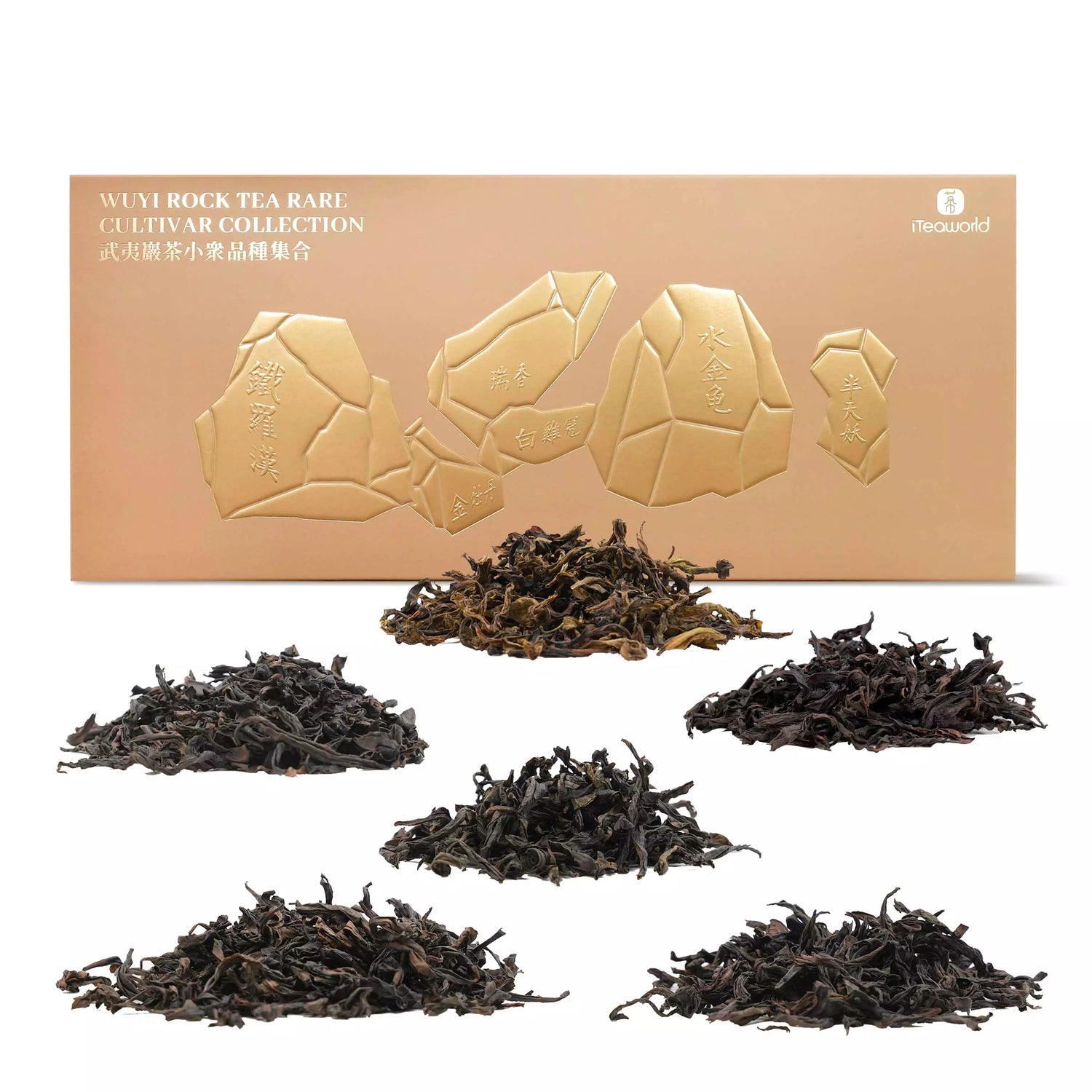
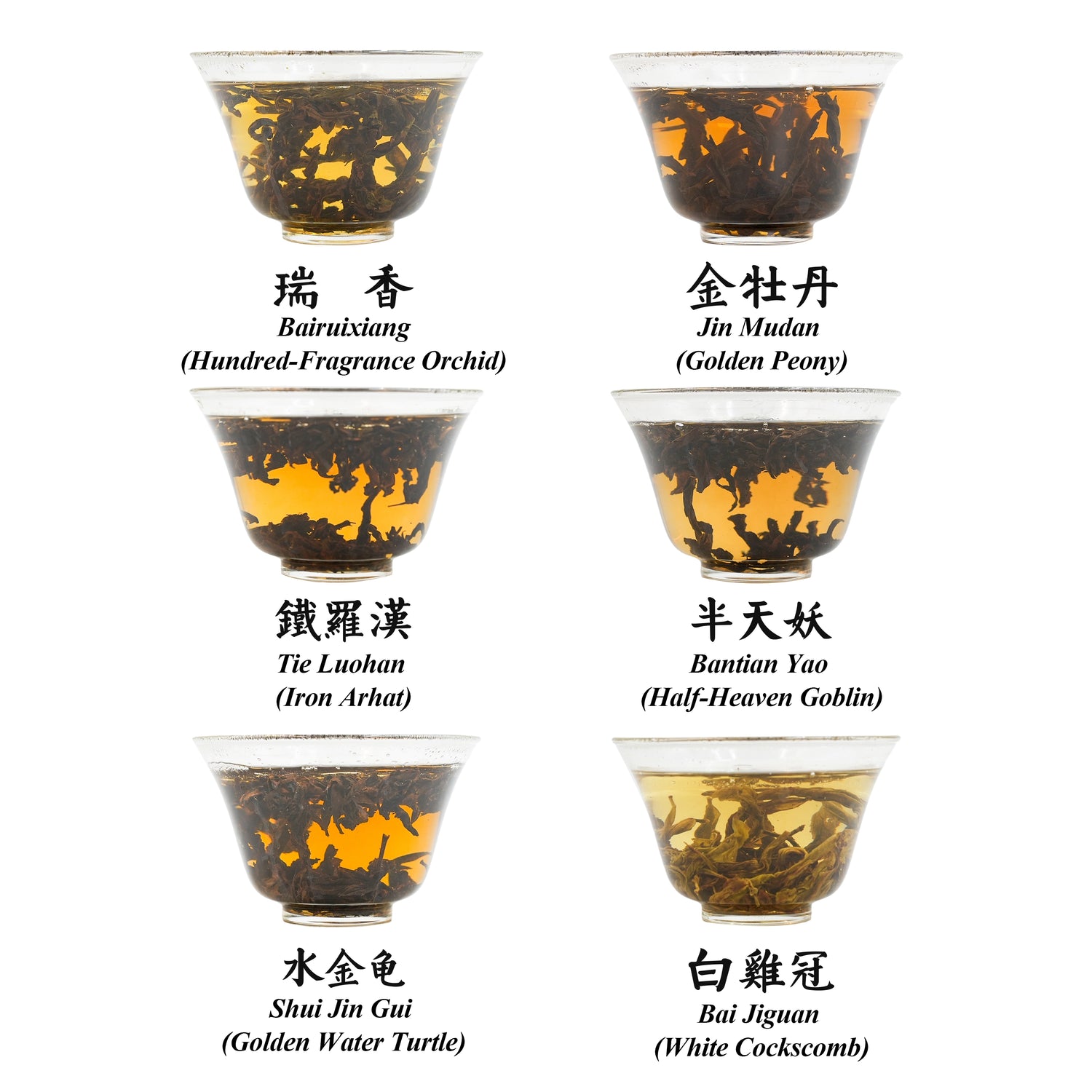
Коллекция редких сортов чая с утеса Уи — наследие и инновации, 100 г
$52.99 USD
Цена за единицу товара заКоллекция редких сортов чая с утеса Уи — наследие и инновации, 100 г
$52.99 USD
Цена за единицу товара за Кому понравится этот чай?
Эта коллекция идеально подходит тем, кто знаком с классическими чаями из Уи и готов глубже погрузиться в их редкие и самобытные сорта. В неё входят такие известные сорта, как Те Лохань, Бань Тянь Яо, Бай Цзи Гуань, Шуй Цзинь Гуй и Бай Жуй Сян, а также новые, пользующиеся большим спросом сорта, такие как Жуй Сян и Цзинь Мудань. Путешествие по многообразию вкусов и мастерству приготовления чая из Уи.
Состав продукта:
Те Луохань (Железный Архат)* 3 пакетика* 5 г
Бай Цзигуан (белый петушиный гребень)* 3 пакетика* 5 г
Шуй Цзинь Гуй (Золотая Водяная Черепаха)* 4 пакетика* 5 г
Бантиан Яо (Полунебесный гоблин)* 3 пакетика* 5 г
Джин Мудан (Золотой Пион)* 4 пакетика* 5 г
Байжуйсян (орхидея со ста ароматами) * 3 пакетика* 5 г
Чайный мастер: Чэнь Хуэй陈辉
Происхождение: деревня Цзиншуй, город Синцунь, город Уишань, провинция Фуцзянь.
Время обработки: ноябрь 2024 г.
Срок годности: 36 месяцев
Высота: 400-600 метров
Почва: Гравийная почва
Окисление: 45-55%
Степень обжарки: средняя
Способ обжарки: обжарка на древесных углях
Редкие сорта чая с горы Уишань: скрытые жемчужины из самого сердца Чжэнъяня
В то время как такие чаи, как Да Хун Пао, Жоу Гуй и Шуй Сянь, стали известными представителями чая из Уи, редкие сорта, такие как Те Ло Хань, Бай Цзи Гуань, Шуй Цзинь Гуй и Бань Тянь Яо, рассказывают более глубокую и аутентичную историю. Эти чаи происходят от диких, старинных чайных деревьев, которые веками росли в самом сердце гор Уи, и формировались естественным отбором и бережным выращиванием. Они воплощают в себе изначальное генетическое наследие чая из Уи.
Эти чайные деревья, произрастающие на отдалённых скалах и обрывистых уступах в основной зоне производства Чжэнъянь, таких как пещера Гуйдун и пик Саньхуа, глубоко пускают корни в расщелины скал, впитывая редкие минералы. В результате получается неповторимый вкусовой профиль с неуловимым и неповторимым «Янь Юнь» (стихотворение скалы), который ценят ценители.
Каждый редкий сорт дарит уникальные вкусовые ощущения:
«Бай Цзи Гуань» обладает легким, сладким ароматом кукурузных рылец.
В аромате Tie Luo Han ощущаются согревающие травяные ноты, напоминающие корень дягиля.
Ban Tian Yao поражает экзотическим букетом гардении, молока и меда — сложным и незабываемым.
Их редкость лишь добавляет им загадочности. Например, Бань Тянь Яо даёт менее 100 фунтов урожая в год. Тем не менее, несмотря на низкую урожайность, эти сорта имеют преданных поклонников среди опытных ценителей чая и коллекционеров. Один из самых выдающихся сортов, Жуй Сян, ценится как «секретное оружие» в премиальных купажах за свой пронзительный, стойкий аромат.
Эти чаи — не просто вкус, они — живое культурное наследие.
Бай Цзи Гуань имеет даосские корни.
Сюжет «Шуй Цзинь Гуй» связан с легендами о золотой черепахе, ищущей справедливости.
Когда-то «Те Ло Хань» был ведущим экспортным товаром в Юго-Восточную Азию.
В эпоху массового производства и стандартизации вкуса эти редкие сорта чая из Уи предлагают смелую альтернативу: многогранность, характер и глубокая связь с терруаром. Их устойчивость к болезням, способность расти в тени и засухе, также открывает перспективы для будущего чайного дела.
Как говорят местные чаеводы: «Жоу Гуй олицетворяет сегодняшний день, но редкие сорта ведут нас в завтрашний день». Знакомство с ними — словно чтение живой энциклопедии чая с утеса Уи: каждый глоток — это страница из архива самой природы.
Как заваривать эти чаи?
-
Основные принципы
Чайная посуда: используйте фарфоровую гайвань (лучше для аромата) или чайник из исинской глины (для усиления насыщенности чая).
Вода: Фильтрованная или родниковая (избегайте жёсткой воды). Температура: Кипение (100°C/212°F) для чая средней/сильной обжарки; 90–95°C (194–203°F) для чая слабой обжарки.
Соотношение: 1:20 чая и воды (например, 5 г/3,8 унции чая на 110 мл/3,8 унции воды). -
Этапы заваривания
Подогрейте чайную посуду: ополосните чашки и чайник горячей водой, чтобы раскрыть ароматы.
Первое полоскание: Залейте листья кипятком и сразу же выбросьте (это пробудит чай).
Заваривание:
Короткие заваривания: начните с 5–10 секунд для первых трех завариваний.
Постепенно увеличивайте время: добавляйте 5–10 секунд на каждое последующее заваривание.
Избегайте чрезмерного настаивания: это предотвращает появление горечи.
Советы для западных людей
Подсказки по вкусу:
«Rock Essence» (Янь Юнь): минеральное послевкусие, напоминающее влажные камни, — признак качества.
Тест на холодную чашку: понюхайте пустую чашку после глотка. Настоящий уишанский чай сохраняет ноты альпийских трав и сливы.
Устранение горечи: сократите время заваривания или используйте более прохладную воду (88–90 °C).
Сочетания: Темный шоколад (для блюд сильной обжарки) или лимонный тарт (для блюд слабой обжарки).
Коллекция ароматов Fenghuang Dancong 10
Откройте для себя суть китайской чайной культуры Гунфу с этим уникальным набором улун Фэнхуан Даньцун, включающим 10 уникальных натуральных ароматов, таких как жасмин, гардения, медовая орхидея и другие. Эта коллекция, известная как «аромат чая», раскрывает многообразие вкусов, создаваемых различными сортами чайных кустов из города Фэнхуан, центра производства чая Даньцун.
Любите ли вы ароматные чаи, цените гунфу или просто интересуетесь богатым ароматом и вкусом улуна, этот набор подарит вам незабываемое чувственное путешествие. Прекрасно подобранный, он станет идеальным подарком для любителей чая, которые ценят аутентичный, ароматный и высококачественный чай.
Что такое чай Фэнхуан Даньцун?
Чай Фэнхуан Даньцун — это разновидность улуна, выращенного в группе Фэнхуан Шуйсянь. Каждое растение имеет уникальную форму и сорт, образуя отдельную линейку продукции, отсюда и название «Даньцун», что означает «один куст» или «один сорт». Этот чай отличается способностью выдерживать многократные заваривания, крепким послевкусием и насыщенным, стойким ароматом. Благодаря своему неповторимому аромату он считается самым ароматным улуном. В зависимости от ароматических свойств, Фэнхуан Даньцун подразделяется на различные ароматизированные категории.
В состав продукта входят:
Чай Фэнхуан Даньцун Улун (аромат Хуан Чжи) 2*5 г
Чай Фэнхуан Даньцун Улун (аромат орхидеи) 2*5 г
Чай Фэнхуан Даньцун Улун (аромат медовой орхидеи) 2*5 г
Чай Фэнхуан Даньцун Улун (аромат магнолии) 2*5 г
Чай улун Фэнхуан Даньцун (с ароматом цветков имбиря) 2*5 г
Чай Фэнхуан Даньцун Улун (Аромат Османтуса) 2*5 г
Чай Фэнхуан Даньцун Улун (аромат корицы) 2*5 г
Чай Фэнхуан Даньцун Улун (аромат миндаля) 2*5 г
Чай улун Фэнхуан Даньцун (с ароматом ночи) 2*5 г
Чай Фэнхуан Даньцун Улун (аромат жасмина) 2*5 г
Источник:
Город Фэнхуан, город Чаочжоу, провинция Гуандун.
Знакомство с 10 лучшими ароматами чая Фэнхуан Даньцун
Чай улун Фэнхуан Даньцун (аромат Хуан Чжи) : высококачественный однокустовый чай с натуральным ароматом гардении.
Чай улун Фэнхуан Даньцун (с ароматом орхидеи) : обладает ароматом орхидеи, свежим и тонким.
Чай улун Фэнхуан Даньцун (с ароматом медовой орхидеи) : самый популярный сорт, известный своим насыщенным медовым вкусом в сочетании с ароматом орхидеи, отсюда и название «Милан».
Чай улун Фэнхуан Даньцун (с ароматом магнолии) : свежий и элегантный, с ароматом цветов магнолии.
Чай улун Фэнхуан Даньцун (с ароматом цветков имбиря) : также известен как «Проникающий небесный аромат», так назван из-за бодрящего аромата цветков имбиря при заваривании чая.
Чай улун Фэнхуан Даньцун (с ароматом османтуса) : напоминает цветы османтуса, сладкий и стойкий.
Чай Фэнхуан Даньцун Улун (с ароматом корицы) : назван в честь вкуса чая, напоминающего вкус корицы, традиционного китайского лекарственного средства.
Чай улун Фэнхуан Даньцун ( с ароматом миндаля) : также известен как «Пилообразный», названный так из-за зазубренных краев листьев и ярко выраженного аромата миндаля.
Чай улун Фэнхуан Даньцун (с ароматом ночи) : Даньцун с ароматом ночи славится своим уникальным вечерним ароматом и вкусом. Он производится в основном на озере Фэнси-Дань в городе Фэнхуан и довольно редок.
Чай улун Фэнхуан Даньцун (с ароматом жасмина) : уникальный аромат с ароматом цветов жасмина, освежающий и восхитительный.
Советы по завариванию пива
Рекомендуемый метод: традиционный стиль Гунфу.
Лучшая чайная посуда: белая фарфоровая гайвань или чайник из исинской глины.
Соотношение чая и воды: используйте 5 г чая на 100 мл воды.
Температура воды: 212℉ (100℃).
Время заваривания:
Первое ополаскивание: быстро слейте воду и вылейте ополаскиватель.
2–5-й заваривания: настаивать 6–8 секунд.
6–10-й заваривания: настаивать 10–15 секунд.
Долговечность заваривания: настоящий Даньцун из региона Фэнхуан города Чаочжоу можно заваривать 12–15 раз.
Техника приготовления: лейте воду по краю гайвани тонкой струйкой. Слегка наклоните крышку, оставив небольшой зазор, чтобы избежать чрезмерного испарения.
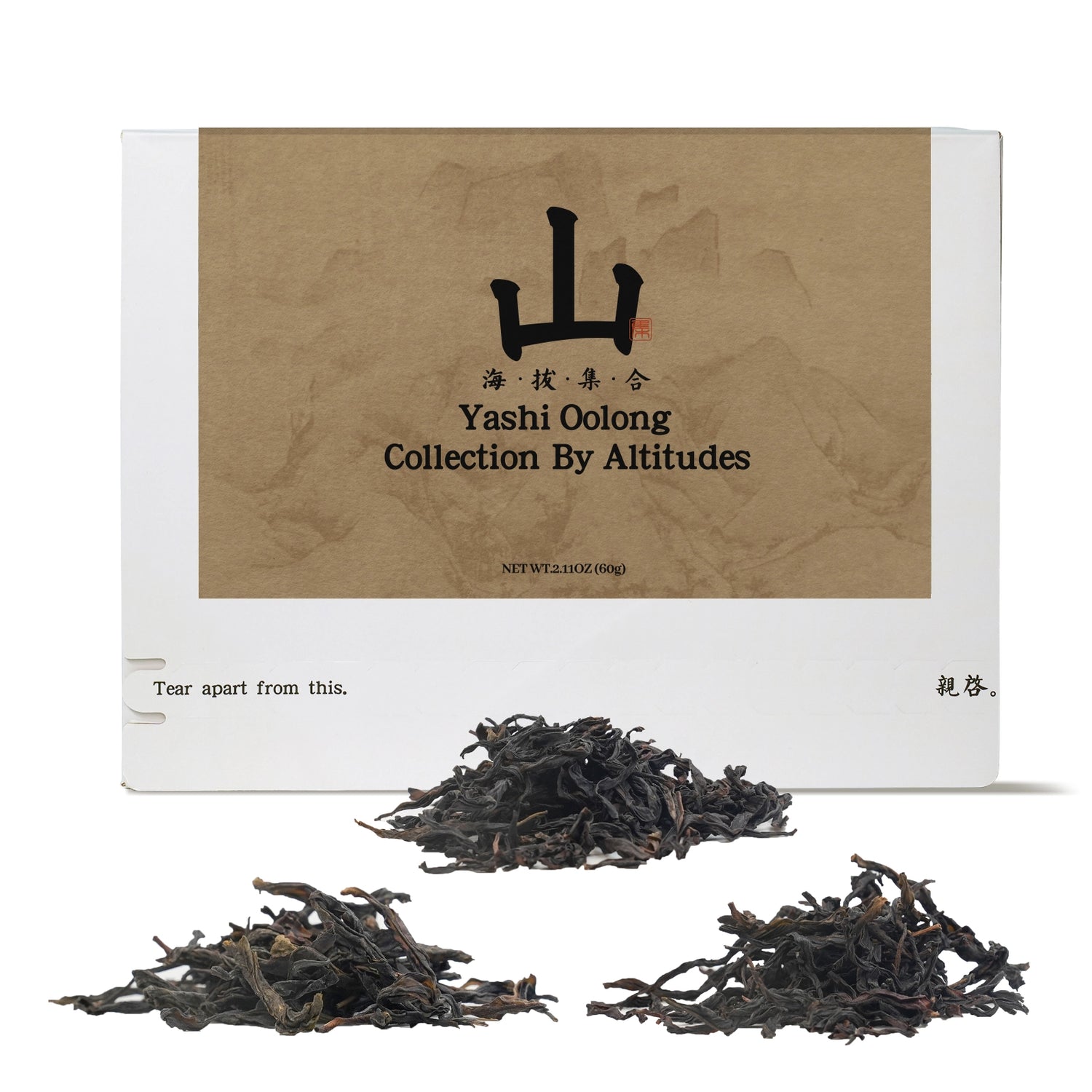
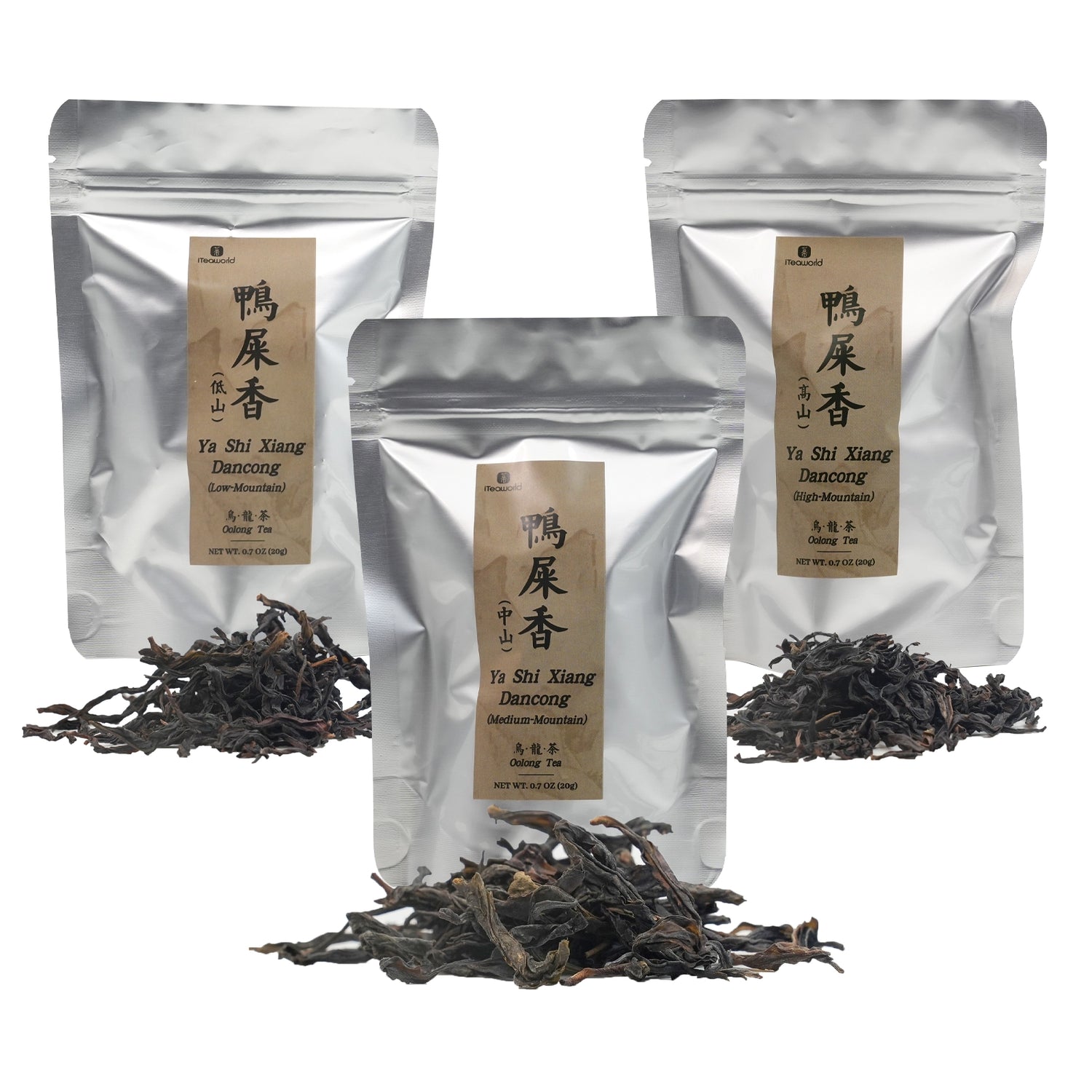
Сравнительный набор улунов Я Ши Сян: от низких до высоких гор 60 г
$34.99 USD
Цена за единицу товара заСравнительный набор улунов Я Ши Сян: от низких до высоких гор 60 г
$34.99 USD
Цена за единицу товара заСтоит ли покупать высокогорный чай? Этот продукт может помочь вам принять решение
Высокогорный чай выращивают в регионах с большой разницей температур днем и ночью, более прохладными температурами и частой облачностью. Эти условия замедляют рост чая, сохраняя листья нежными и богатыми аминокислотами. В результате чай получается более сладким, свежим и ароматным. Высокогорные чаи идеально подходят для легких и средних уровней окисления и обжарки. Примерами высокогорных улунов являются Taiwan High Mountain Tea и Phoenix Dan Cong.
С другой стороны, чаи, произрастающие на низких высотах, обычно содержат больше полифенолов, но имеют более слабый аромат и меньшую выносливость при многократном заваривании.
В этом продукте представлены три чая Duck Shit Oolong, все они созданы одним и тем же мастером чая в городе Фэнхуан с похожими уровнями окисления и обжарки. Единственное различие — высота, на которой они были выращены, что позволяет легко сравнить, как высота влияет на вкус чая.
Включенные продукты:
- Я Ши Сян (Утиное дерьмо) Дан Цун Улун (Низкогорный) 20г
- Я Ши Сян (Утиное дерьмо) Дан Цун Улун (Средне-горный) 20г
- Я Ши Сян (Утиное дерьмо) Дан Цун Улун (Высокогорный) 20г
Источник:
- Нижний холм: деревня Хутоу, город Фэнхуан, город Чаочжоу, провинция Гуандун, Китай
- Средняя гора: водохранилище Фэнси, город Фэнхуан, город Чаочжоу, провинция Гуандун, Китай.
- Высокая гора: деревня Дунцзяо, город Фэнхуан, район Чаоань, город Чаочжоу, провинция Гуандун, Китай.
Мастер купажа : Линь Чжицян
Время обработки: июнь 2023 г.
Срок годности: 36 месяцев
Сорт чая: сорт Я Ши Сян
Высота:
- Низкогорье: 300-400 метров
- Среднегорный: 600 метров
- Высокогорье: 800-900 метров
Тип почвы: желтая почва
Степень окисления: 30-40%
Степень обжарки:
- Низкогорье: две обжарки, средне-слабый огонь (95-105°C / 203-221°F)
1-я обжарка: июнь-июль 2023 г., 2-я обжарка: после Праздника середины осени 2023 г. - Средне-горный: две обжарки, средне-слабый огонь (95-105°C / 203-221°F)
- Высокогорье: три обжарки, средне-слабый огонь (95-105 °C / 203-221 °F),1-я обжарка: июнь-июль 2022 г.,2-я обжарка: после Праздника середины осени 2022 г.,3-я обжарка: после китайского Нового года 2023 г.
Метод обжарки (уголь или электричество): брикетирование древесного угля
Рекомендации по завариванию:
Заваривание улуна в китайском стиле
Чайная утварь: гайвань или глиняный чайник.
Температура воды: 212°F (100°C)
Соотношение чая и воды: 1 г на 0,7 унции (20 мл)
Время заваривания: 10-15 сек (1-3 заваривания), добавить 5-10 сек после
Повторное заваривание: до 7 раз
Заваривание улуна в западном стиле
Чайная утварь: чайник, заварник или френч-пресс.
Температура воды: 190-200°F (88-93°C)
Соотношение чая и воды: 1 ч. л. (2-3 г) на 8 унций (240 мл)
Время заваривания: 3-5 минут
Повторное заваривание: до 3 раз, каждый раз добавляя по 1-2 минуты.
Почвенная среда
В «Классике чая» Лу Юя упоминается, что чайные деревья лучше всего растут на разных типах почв: «лучшие растут на гнилых камнях, средние на гравийной почве и худшие на желтой земле». Каменистая почва обеспечивает хороший дренаж и циркуляцию воздуха, предотвращая как заболачивание во время сильных дождей, так и сухость во время засухи. Она богата минералами, и чайные деревья процветают на почве, которая одновременно влажная и кислая. Например, лучшие скальные чаи Уи растут на почве, состоящей из гнилых камней и гравия. С другой стороны, более низкосортные чаи Уи, которые в основном растут на желтой земле, не имеют характерного каменистого привкуса и имеют более простые, менее сложные ароматы и вкусы.
Если вы хотите ощутить, как разные типы почв влияют на вкус улуна, лучшим примером будет коллекция чаёв с утеса Уишань, собранных в разных местах. Сюда входят:
Основной чай Чжэнъянь Уи: известен своей каменистой, щебнистой почвой, представленной знаменитыми Тремя ямами и Двумя ручьями (Сань Кэн Лян Цзянь).
Чай Уи Чжэнъянь: выращивается на почвах, богатых песчано-гравийными породами.
Чай Уи Бан Янь: выращивается на толстых слоях каменистой красной почвы.
Чай Уичжоу: выращивается на почвах с преобладанием лёсса (желтой земли).
В комплект входят:
- Чай Core Zhengyan Wuyi (Core Zheng Yan) 10 г
- Уи Роу Гуй (Чжэн Янь) 10г
- Wuyi Rou Gui (Чай Бан Янь) 20г
- Уи Роу Гуй (Чжоу Ча) 20г
Источник:
- Ядро Чжэн Янь: Уюань Цзянь, деревня Тяньсинь, город Уи, город Уишань, провинция Фуцзянь
- Чжэн Янь: деревня Тяньсинь, город Уи, город Уишань, провинция Фуцзянь
- Чай Бан Янь: деревня Цзиншуй, город Синцунь, город Уишань, провинция Фуцзянь, Китай.
- Чжоу Ча: город Синтянь, город Уишань, провинция Фуцзянь, Китай
Мастер купажа:
- Чэнь Хуэй
Время обработки:
- Октябрь 2024 г.
Срок годности:
- 36 месяцев
Сорт чая:
- Сорта корицы Уи
Высота:
- Ядро Чжэн Янь: 342 метра
- Чжэн Янь: 400-500 метров.
- Чай Бан Ян: около 400 метров
- Чжоу Ча: около 200 метров
Тип почвы:
- Основной материал Чжэн Янь: Гравийный грунт
- Чжэн Янь:песчано-гравийная почва
- Чай Баньян: красная почва с преобладанием толстослойных пород
- Чжоу Ча: желтая почва
Степень окисления : средняя (45-55%)
Степень обжарки:
- Основная часть Чжэн Янь: три обжарки, сильный огонь, 105-110 °C (221-230 °F)
- Чжэн Янь: три обжарки на сильном огне, 105–110 °C (221–230 °F)
- Чай Баньян: три обжарки, сильный огонь, 105-110°C (221-230°F)
- Чжоу Ча: Два обжаривания на среднем огне, около 115°C (239°F)
Метод обжарки (уголь или электричество):
- брикетирование древесного угля
Рекомендации по завариванию:
Заваривание улуна в китайском стиле
Чайная посуда: гайвань или глиняный чайник
Температура воды: 212°F (100°C)
Соотношение чая и воды: 1 г на 0,7 унции (20 мл)
Время заваривания: 15 секунд (1–3 заваривания), затем добавьте 5–10 секунд
Повторное заваривание: до 7 раз
Заваривание улуна в западном стиле
Чайная утварь: чайник, заварник или френч-пресс
Температура воды: 212°F (100°C)
Соотношение чая и воды: 1 ч. л. (2–3 г) на 8 унций (240 мл)
Время заваривания: 3 минуты
Повторное заваривание: 3 раза, каждый раз добавляя по 1 минуте.
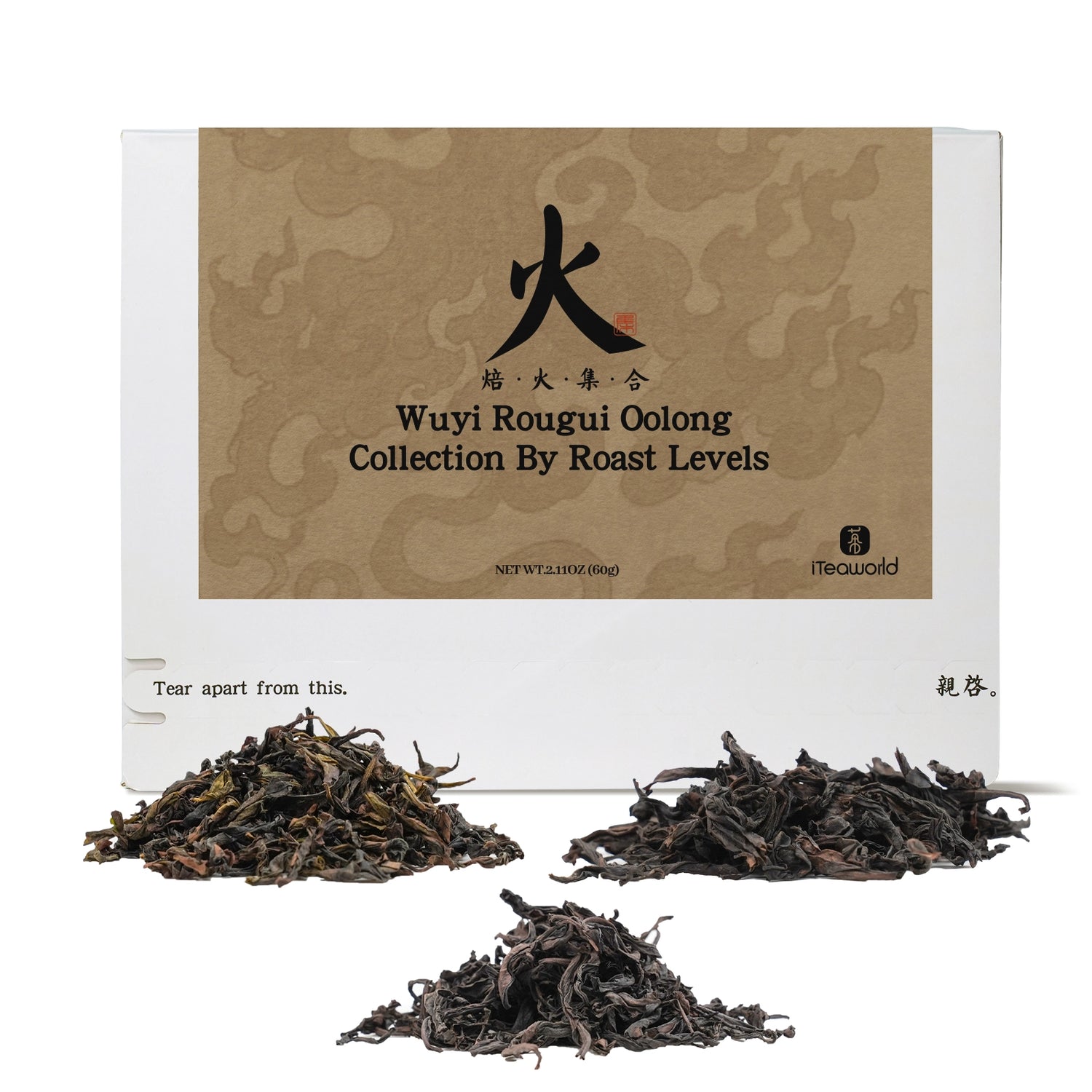
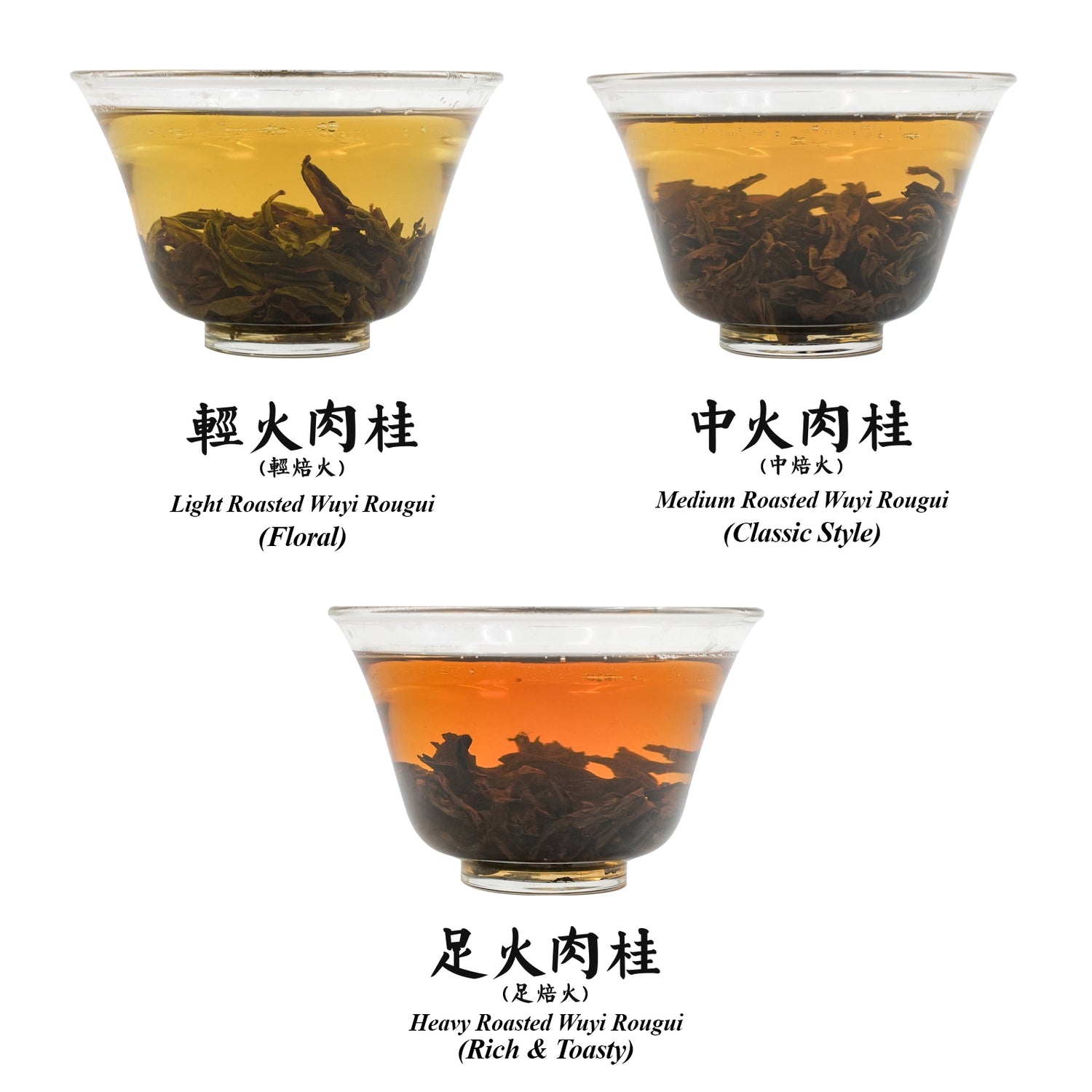
Набор для сравнения Уишаньского улуна: 3 уровня обжарки (от слабого до сильного), 60 г
$24.99 USD
Цена за единицу товара заНабор для сравнения Уишаньского улуна: 3 уровня обжарки (от слабого до сильного), 60 г
$24.99 USD
Цена за единицу товара заИскусство обжарки чая улун
Обжарка улуна преследует три основные цели: снижение влажности, удаление посторонних привкусов и снижение содержания кофеина, при этом усиливая аромат и вкус чая. Чаи с разной степенью окисления требуют разной степени обжарки. Обычно слабоокисленные чаи слегка обжаривают для усиления их вкуса. Если чай слегка окислился, но сильно обжарился, он может иметь слишком дымный привкус, часто из-за того, что окисление было проведено неправильно, а обжарка используется для его маскировки.
Степень обжарки существенно влияет на аромат и вкус чая. Легкая обжарка сохраняет свежий цветочный аромат, в то время как сильная обжарка создает более насыщенный, мягкий напиток с поджаренными или дымными оттенками.
Этот чай содержит улун Wuyi Rougui из знаменитых гор Уи в провинции Фуцзянь, созданный тем же мастером чая. Единственное отличие заключается в уровне обжарки, что дает вам прекрасную возможность изучить, как обжарка формирует вкусы чая улун.
Происхождение: деревня Цзиншуй, город Синцунь, город Уишань, провинция Фуцзянь, Китай.
Мастер купажа : Чэнь Хуэй
Время обработки: ноябрь 2024 г.
Срок годности: 24 месяца
Сорт чая: Уишаньский коричный
Высота: около 400 метров
Тип почвы: гравийная почва
Степень окисления: Окисление 45-55%
Уровень обжарки: одинарная обжарка: легкая обжарка, 90–100 °C (194–212 °F)
Тройная обжарка: средняя обжарка, 105–115 °C (221–239 °F)
Тройная обжарка (полный огонь): сильная обжарка, 120–130 °C (248–266 °F)
Метод обжарки (уголь или электричество):
Светлая корица: электрическая обжарка 20 г
Корица средней интенсивности: брикетирование древесного угля 20 г
Full Flame Cinnamon: брикетированный древесный уголь 20 г
Рекомендации по завариванию:
Заваривание улуна в китайском стиле
Чайная утварь: гайвань или глиняный чайник.
Температура воды: 212°F (100°C)
Соотношение чая и воды: 1 г на 0,7 унции (20 мл)
Время заваривания: 10-15 сек (1-3 заваривания), добавить 5-10 сек после
Повторное заваривание: до 7 раз
Заваривание улуна в западном стиле
Чайная утварь: чайник, заварник или френч-пресс.
Температура воды: 190-200°F (88-93°C)
Соотношение чая и воды: 1 ч. л. (2-3 г) на 8 унций (240 мл)
Время заваривания: 3-5 минут
Повторное заваривание: до 3 раз, каждый раз добавляя по 1-2 минуты.
$49.99 USD
Цена за единицу товара заВозможно, вы не поклонник выдержанных чайных деревьев
И в пуэре, и в улуне возраст чайного дерева имеет значение. Как правило, старые деревья встречаются реже, что повышает их цену. Возраст деревьев имеет наибольшее значение в некоторых сортах улунов, таких как Шуйсянь (включая Феникс Шуйсянь, Уи Шуйсянь и Минбэй Шуйсянь).
Обычно молодые чайные деревья содержат больше аминокислот, но меньше полифенолов и минералов чая. Это приводит к тому, что чай получается более сладким и свежим, но с более легким, менее сложным вкусом. Такие чаи, как правило, имеют больше цветочных нот и лучше всего подходят для легкой ферментации и обжарки.
С другой стороны, старые чайные деревья, как правило, имеют более высокий уровень полифенолов чая, клетчатки, сахаров и минералов. Они не так ограничены методами обработки, и полученные чаи часто более насыщенные, с более выраженной сладостью, более длительным послевкусием и лучшей выносливостью для многократных завариваний.
В этом продукте представлены Phoenix Shui Xian и Wuyi Shui Xian из одного и того же источника, изготовленные с помощью схожих процессов, но из деревьев разного возраста. Это отличный способ сравнить, как возраст дерева влияет на вкус чая улун.
Включенные продукты:
- Фэнхуан Шуйсянь (до 30 лет)
- Фэнхуан Шуйсянь (30-70 лет)
- Фэнхуан Шуйсянь (более 70 лет)
- Уи Шуйсянь (до 30 лет)
- Уи Шуйсянь (30-70 лет)
- Уи Шуйсянь (более 70 лет)
Источник:
- Фэнхуан Шуйсянь (до 30 лет): деревня Шэньмин, город Фэнхуан, район Чаоань, город Чаочжоу, провинция Гуандун, Китай.
- Фэнхуан Шуйсянь (30-70 лет): деревня Дапин, город Фэнхуан, район Чаоань, город Чаочжоу, провинция Гуандун, Китай.
- Фэнхуан Шуйсянь (более 70 лет): Гезайвэй, деревня Удун, город Фэнхуан, район Чаоань, город Чаочжоу, провинция Гуандун, Китай.
- Уи Шуйсянь (до 30 лет): деревня Цзиншуй, город Синцунь, город Уишань, провинция Фуцзянь, Китай.
- Уи Шуйсянь (30–70 лет): деревня Даан, поселок Янчжуан, город Уишань, провинция Фуцзянь.
- Уи Шуйсянь (более 70 лет): деревня Тяньсинь, поселок Уи, город Уишань, провинция Фуцзянь.
Мастер купажа:
- Фэнхуан Шуйсянь: Линь Цзичжун, 林纪中
- Уи Шуйсянь: Чэнь Хуэй, 陈辉
Время обработки:
- Фэнхуан Шуйсянь: начало мая 2023 г.
- Уи Шуйсянь: май 2024 г.
Дата годности:
- 36 месяцев
Сорт чая:
- Сорт Фэнхуан Шуйсянь
- Сорт Уи Шуйсянь
Высота:
- Фэнхуан Шуйсянь (до 30 лет): 760 метров.
- Фэнхуан Шуйсянь (30-70 лет): 800-90 метров.
- Фэнхуан Шуйсянь (более 70 лет): 1150 метров.
- Уи Шуйсянь (до 30 лет): 400 метров.
- Уи Шуйсянь (30-70 лет): 800-900 метров.
- Уи Шуйсянь (более 70 лет): 500 метров.
Тип почвы:
- Фэнхуан Шуйсянь: желтая почва
- Уи Шуйсянь: гравийная почва
Уровень окисления:
- Средняя степень окисления (40-50%)
Степень обжарки:
- До 30 лет (вариант 1): три обжарки на среднем огне (110–115 °C / 230–239 °F)
- 30–70 лет (вариант 1): три обжарки на средне-сильном огне (110–115 °C / 230–239 °F)
- Более 70 лет (вариант 1): три обжарки на среднем огне (110–115 °C / 230–239 °F)
- До 30 лет (вариант 2): две обжарки на сильном огне (110–115 °C / 230–239 °F)
- 30–70 лет (вариант 2): три обжарки, слабый огонь (95–105 °C / 203–221 °F)
- Более 70 лет (вариант 2): слабый огонь, 95–105 °C (203–221 °F)
- (Слабый огонь ~ 80°C, Средний огонь ~ 100°C, Сильный огонь ~ 120°C)
Метод обжарки (уголь или электричество):
- брикетирование древесного угля
Рекомендации по завариванию:
Заваривание улуна в китайском стиле
Чайная утварь: гайвань или глиняный чайник.
Температура воды: 212°F (100°C)
Соотношение чая и воды: 1 г на 0,7 унции (20 мл)
Время заваривания: 10-15 сек (1-3 заваривания), добавить 5-10 сек после
Повторное заваривание: до 7 раз
Заваривание улуна в западном стиле
Чайная утварь: чайник, заварник или френч-пресс.
Температура воды: 100°C (212°F)
Соотношение чая и воды: 1 ч. л. (2-3 г) на 8 унций (240 мл)
Время настаивания: 3 минуты
Повторное заваривание: 3 раза, каждый раз добавляя по 1 минуте.

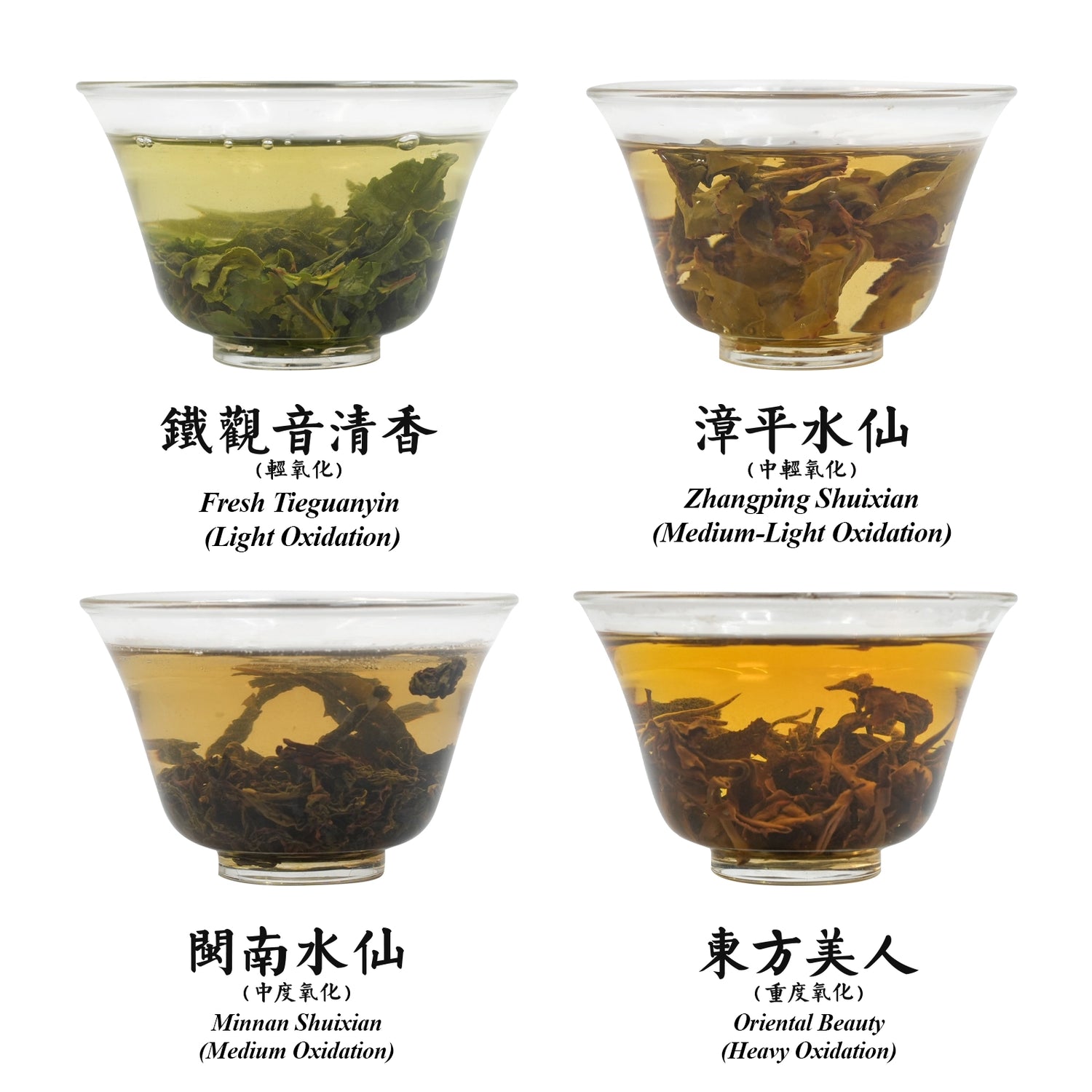
Набор для сравнения чая улун: 4 степени окисления (от Тегуаньинь до Восточной Красавицы), 80 г
$34.99 USD
Цена за единицу товара заНабор для сравнения чая улун: 4 степени окисления (от Тегуаньинь до Восточной Красавицы), 80 г
$34.99 USD
Цена за единицу товара заЧай улун: баланс окисления
Чай улун — это частично окисленный чай, степень окисления которого составляет от 10% до 70%. Окисление играет ключевую роль в формировании аромата чая и яркости его вкуса. Легкое окисление создает свежие цветочные и фруктовые ноты, в то время как более сильное окисление выявляет более насыщенные, зрелые фруктовые или медовые ароматы.
Слабоокисленный улун (10–25 %): такие примеры, как Вэнь Шань Баочжун и слабообжаренный Тегуаньинь, демонстрируют свежие цветочные и фруктовые ароматы.
Умеренно окисленный улун (25–50 %): такие чаи, как Феникс Дань Цун и Тегуаньинь средней обжарки, имеют сбалансированный профиль, сочетающий цветочные ноты с оттенками меда, фруктов или обжарки, что приводит к сложному аромату.
Сильно окисленный улун (50–70 %). Такие классические сорта, как Да Хун Пао, Уи Ругуй и Восточная красавица, обладают ароматами зрелых фруктов, нотками жареного или карамельного вкуса и мягким, насыщенным напитком.
Этот продукт включает четыре известных чая улун, все слегка обжаренные, но с разной степенью окисления. Это идеальный способ изучить, как разные степени окисления влияют на вкус и аромат чая улун.
Включенные продукты:
- Свежий Тегуаньинь (легкое окисление) 20 г
- Чай Чжанпин Шуйсянь Улун (средней легкой степени окисления) 20г
- Миннан Шуйсянь (среднего окисления) 20г
- Oriental Beauty (сильное окисление) 20 г
Источник:
- Свежий Тегуаньинь: деревня Лунцзюань, поселок Лунцзюань, уезд Аньси, провинция Фуцзянь, Китай
- Чжанпин Шуйсянь: деревня Бэйляо, город Наньян, город Чжанпин, провинция Фуцзянь, Китай.
- Миннань Шуйсянь: деревня Уси, город Уфэн, округ Юнчунь, город Цюаньчжоу, провинция Фуцзянь, Китай.
- Восточная красавица: деревня Нэйян, поселок Пиншань, город Саньмин, провинция Фуцзянь, Китай
Мастер купажа :
- Свежий Тегуаньинь: Чэнь Цичжи
- Чжанпин Шуйсянь: Хэ Мэйцин
- Миннан Шуйсянь: Сюй Юнъюань
- Восточная красавица: Ли Цзяньминь
Время обработки:
- Свежий Тегуаньинь: ноябрь 2024 г.
- Чжанпин Шуйсянь: июнь 2024 г.
- Миннан Шуйсянь: декабрь 2024 г.
- Oriental Beauty: начало июня 2024 г.
Срок годности: 24 месяца
Сорт чая:
- Тегуаньинь: разновидности Тегуаньинь
- Чжанпин Шуй Сянь: сорта Миннань Шуйсянь
- Миннан Шуйсянь: сорта Цзяньян Шуй Сиань
- Восточная красавица: сорт Цзинь Сюань
Высота:
- Тегуаньинь: 800-900 метров
- Чжанпин Шуй Сиань: 400-500 метров
- Миннан Шуйсянь: 900-1000 метров.
- Восточная красавица: 1100 метров
Тип почвы:
- Тегуаньинь: красная почва
- Чжанпин Шуй Сянь: желтая и красная почва
- Миннан Шуйсянь: красная почва
- Восточная красавица:Красная почва
Уровень окисления:
- Тегуаньинь: Легкое окисление (10-20%)
- Чжанпин Шуй Сянь: слабое окисление (25-30%)
- Миннан Шуйсянь: Среднее окисление (40-50%)
- Oriental Beauty: Сильное окисление (60-70%)
Степень обжарки:
- Очень легкая обжарка, 70-80°C (158-176°F)
Метод обжарки (уголь или электричество):
- электрическая жарка
Рекомендации по завариванию:
Заваривание улуна в китайском стиле
Чайная утварь: гайвань или глиняный чайник.
Температура воды: 212°F (100°C)
Соотношение чая и воды: 1 г на 0,7 унции (20 мл)
Время заваривания: 10-15 сек (1-3 заваривания), добавить 5-10 сек после
Повторное заваривание: до 7 раз
Заваривание улуна в западном стиле
Чайная утварь: чайник, заварник или френч-пресс.
Температура воды: 90-100°C (194-212°F)
Соотношение чая и воды: 1 ч. л. (2-3 г) на 8 унций (240 мл)
Время заваривания: 3-5 минут
Повторное заваривание: до 3 раз, каждый раз добавляя по 1-2 минуты.
Recently viewed products
Chat with fellow tea lovers, ask questions, and share your tea moments.





